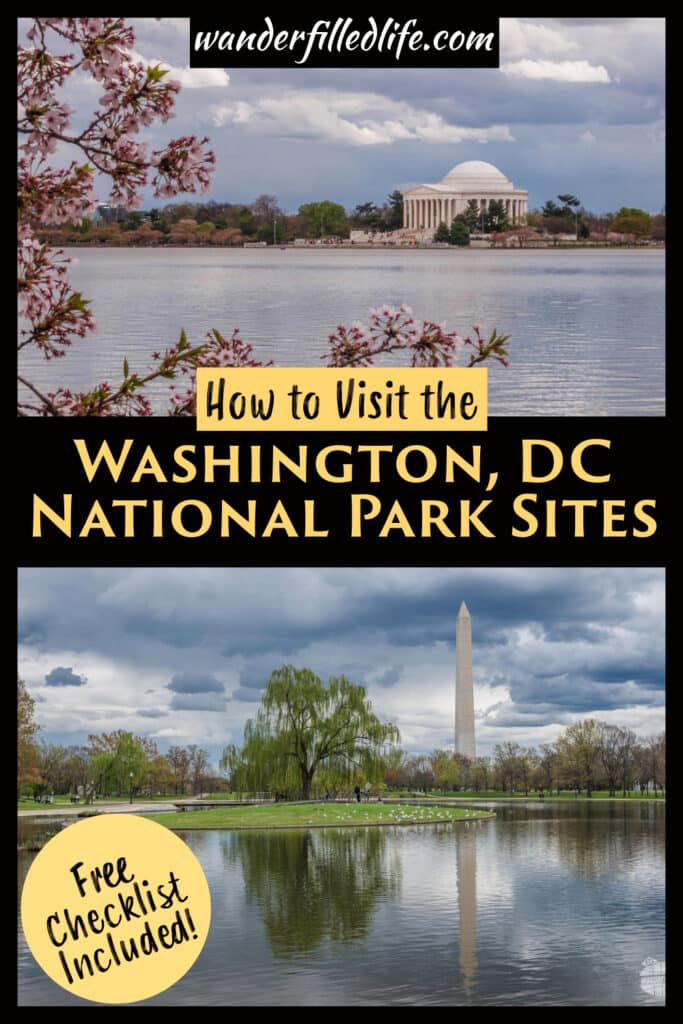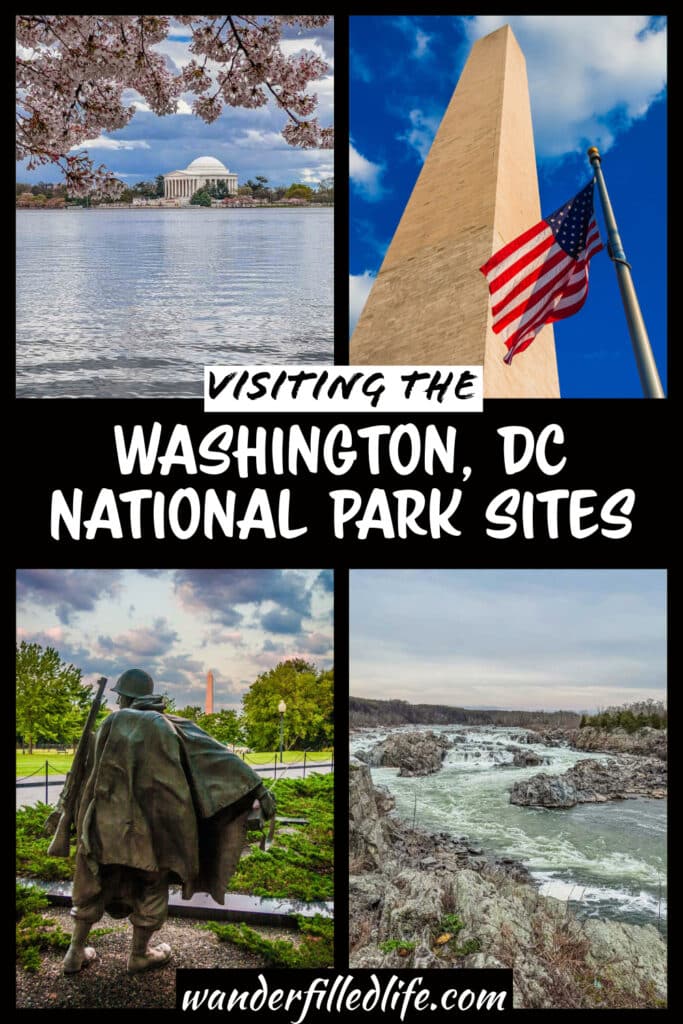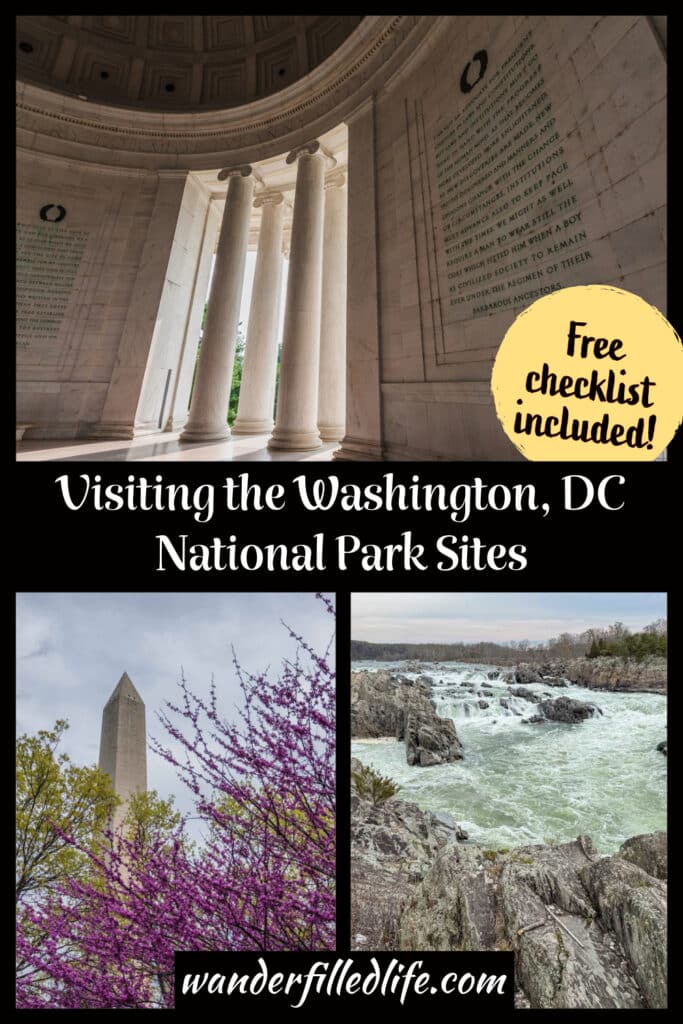You may not realize it but Washington, DC is chock full of national parks. No, these parks don’t have the official “National Park” designation in their name. But they are units of the National Park Service and just as worthy of a visit. In fact, no visit to the nation’s capital would be complete without a visit to at least a few of the Washington, DC national parks.
That’s because many of the monuments and memorials around the National Mall actually are national parks. Even the White House is a national park.
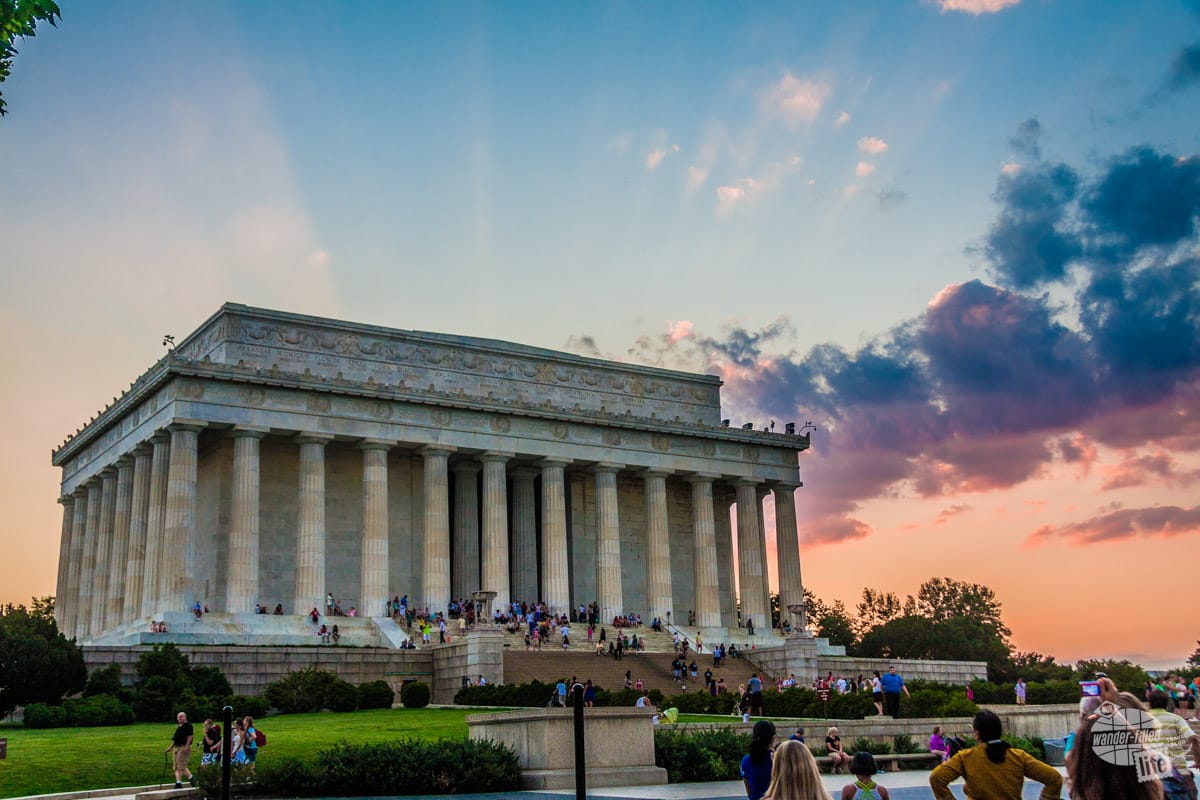
So, just how many national parks are there in Washington, DC? In DC proper, there are 25 official parks. But there are many more in the surrounding metro area. And many of these parks have multiple units.
For national park geeks, like us, who are looking to visit all 400+ national parks, Washington, DC is a great place to “check off” a lot of parks on one trip.
That’s exactly what we did when we visited Washington, DC in April 2024. This was not our first visit to DC. Our first trip together was in 2011. But this was our first visit since we got serious about visiting ALL of the national parks. And, it was our first visit since starting this blog.
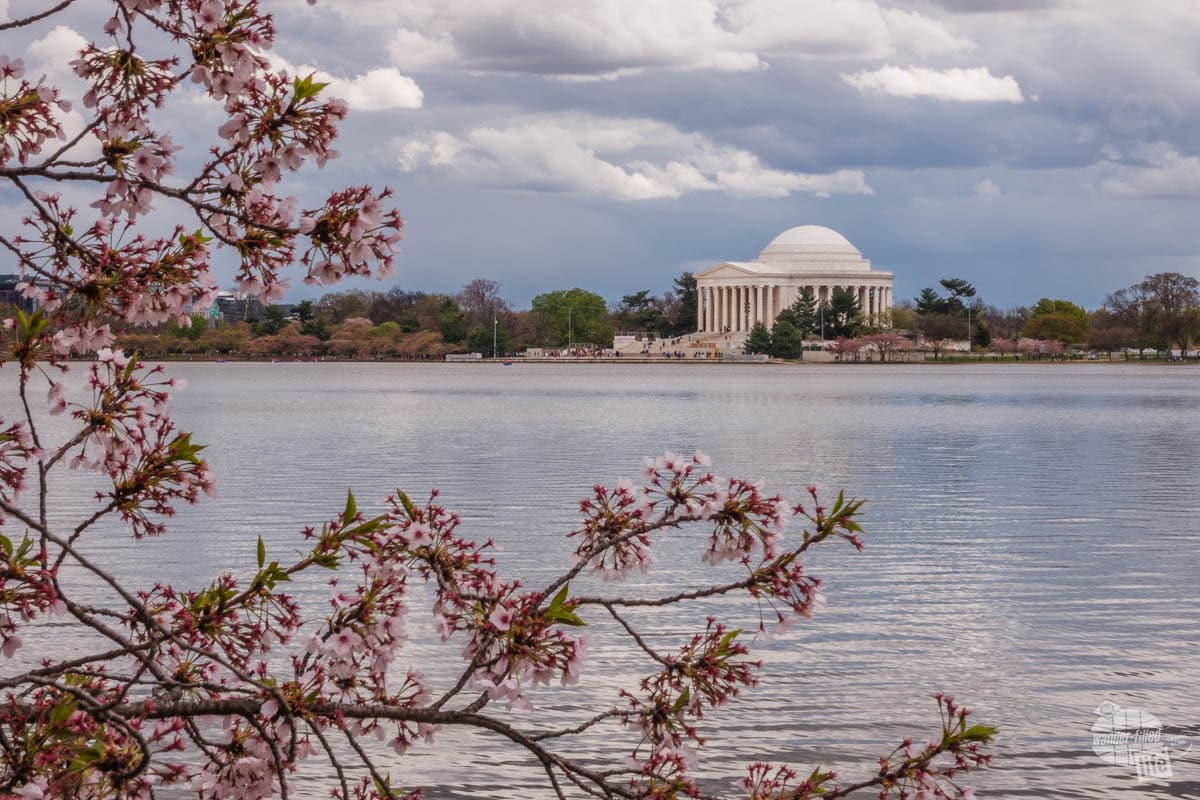
That said, we have been to the mid-Atlantic region a few times since 2016 visiting (and writing about) some of the parks on the outer edges of the DC metro area.
So, if you’re interested in visiting all the national parks in the Washington, DC area, this article is for you. Below, I’ll help you determine just what “counts” as a national park, what parks you can visit with and without a car and how much time you’ll need to see all the national parks in and around DC.
(Disclaimer: When we link to places where you can buy our stuff or places we stayed, we are using special codes that earn us commissions on the sales at no additional cost to you. Please see our Review Policy for more information.)
What are the National Parks in Washington, DC?
I’m going to be honest, one of the most frustrating things about visiting the national parks in the Washington, DC area is figuring out exactly which ones “count.” If you look at the NPS website for “DC Area National Parks,” there are 50 parks named.
But, if you look at the list of 429 units/parks by naming designation, there are 25 parks in Washington, DC and another 10-15 in the surrounding area. I give a range here because everyone will have a different opinion of how far “out” you’d be willing to travel from the city center. In fact, some of the parks on the list of 50 in the DC area are more than an hour away.
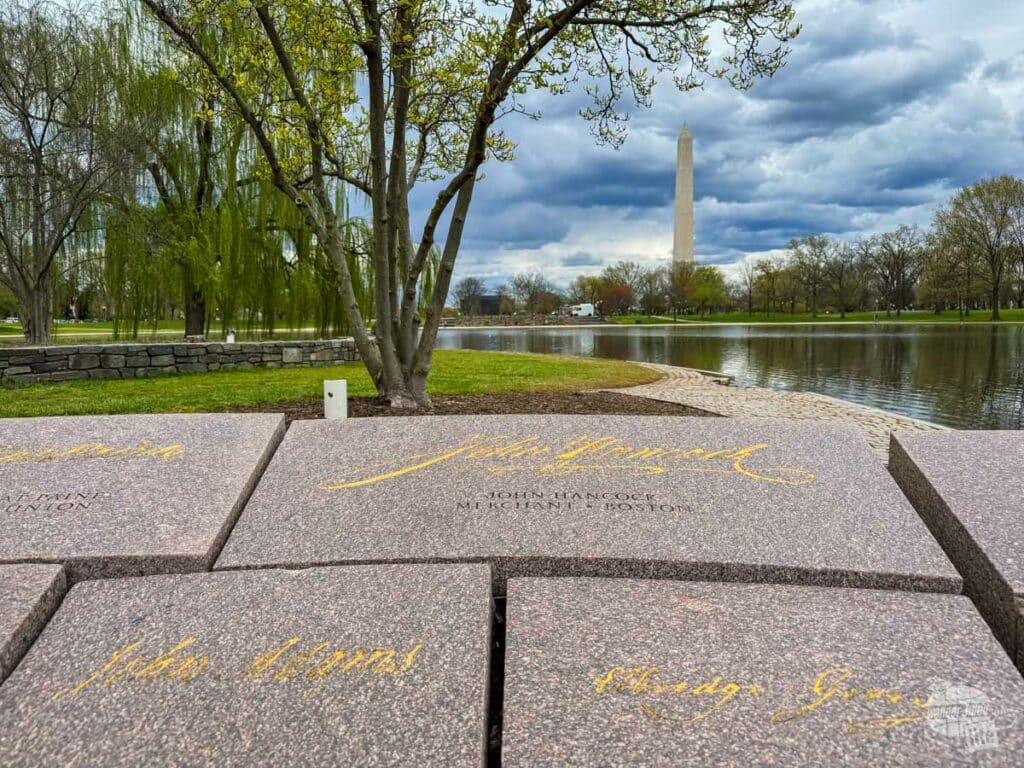
You’ll find yet another number if you count the DC area parks in the NPS app.
Why the discrepancy? Mostly because Congress has made a complete mess of the official designations of national park sites. Additionally, the NPS management structure of some of the sites is a bit wonky. But, that’s not the point of this article.
So, we’ll help you sort out what parks count and how the management is structured. Most importantly, we will spell out which parks count if, like us, you are trying to visit EVERY unit of the National Park Service.
So, Which Parks Count?
Of the 50 “DC Area Parks,” 38 of them are parks that “count” on their own. The rest are units within other parks. We think that is more than a little confusing and somewhat misleading.
In another twist, many DC national parks have more than one unit. Sometimes those units also count as their own park. Other times they don’t count on their own.
One example of this is the “National Mall and Memorial Parks,” which is one of the official 400+ national parks. It includes many of the monuments around the Mall that you would expect it to, such as the Washington Monument and the Vietnam Veterans Memorial. But, both of these are also listed as their own park.
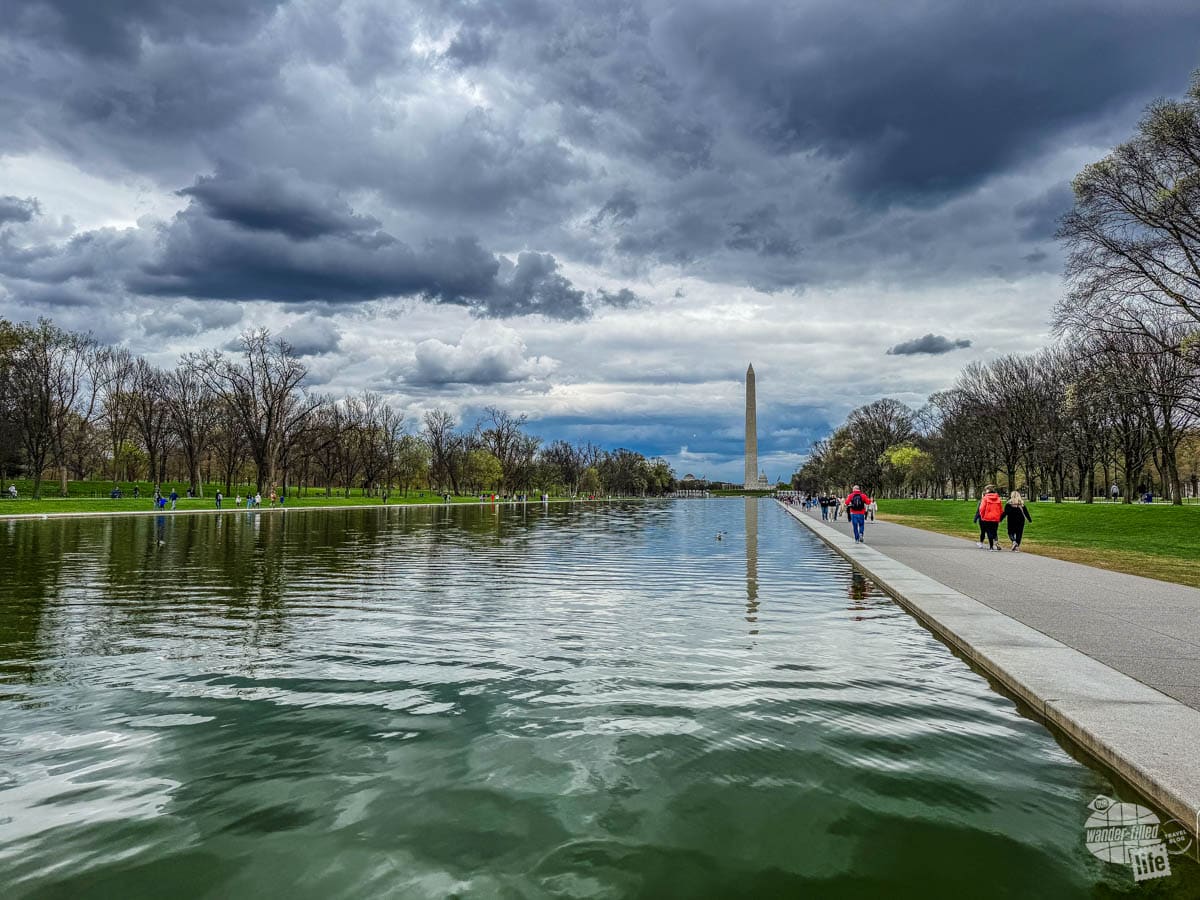
Yes, it’s a mess. But the bottom line is that many parks in and around Washington, DC are considered national parks that you’ll want to visit if you are seeking to visit all 400+ parks managed by the National Park Service.
So, let’s dive in and take a look at just where these parks are and what you need to know before visiting all of the national parks in the Washington, DC area.
Note: Our list is based on the NPS “DC Area National Parks” but edited to include only parks that count as an individual unit. There are a few parks that you may think are too far away to truly be considered DC parks. On the flip side, there are a few in Maryland and Virginia that could be considered DC area parks but are not on the list. You can determine how far out from the city you are willing to travel based on the time you have.
The National Mall
As mentioned previously, the National Mall and Memorial Parks is one unit within the National Park Service. This park manages more than 1,000 acres of land and 14 individual units. All visitors to Washington, DC simply must spend time wandering around the National Mall and visiting the many monuments and memorials there.
You’ll probably want at least half a day at the National Mall. That said, you could spend as much as a full day in the area, depending on how fast you move and your particular interests.
You really don’t need much of a plan when it comes to visiting the National Mall, other than perhaps a list of memorials you don’t want to miss.
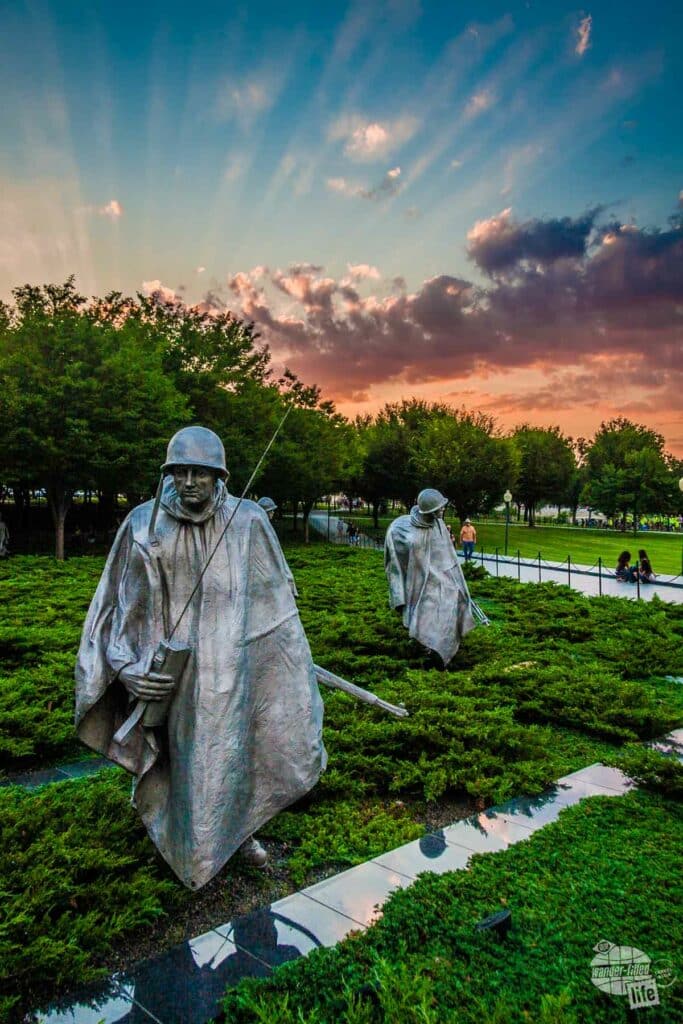
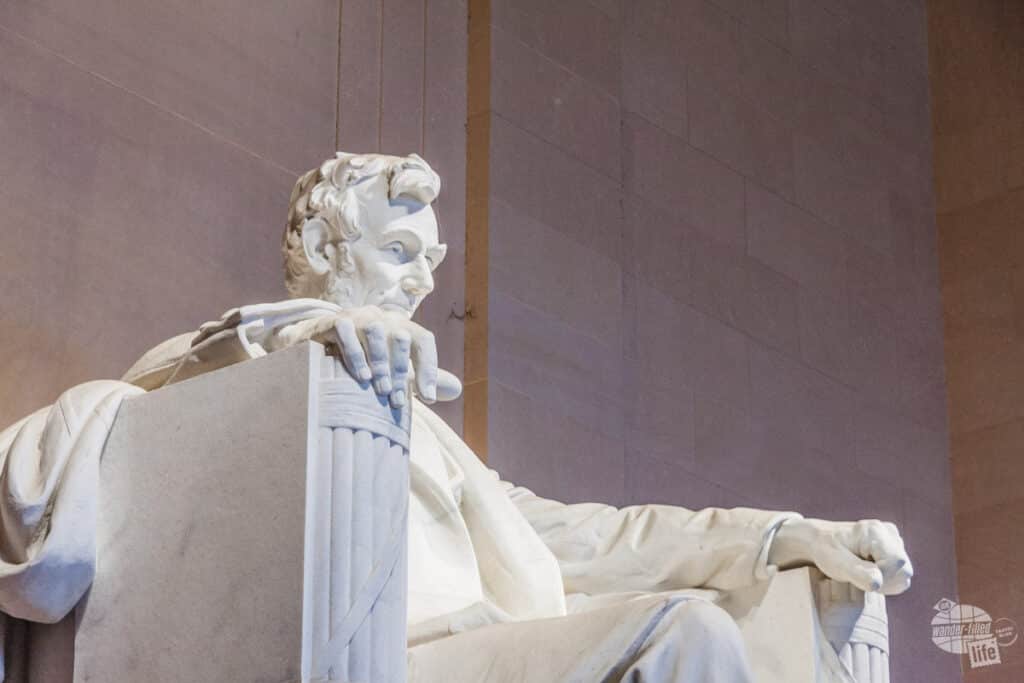
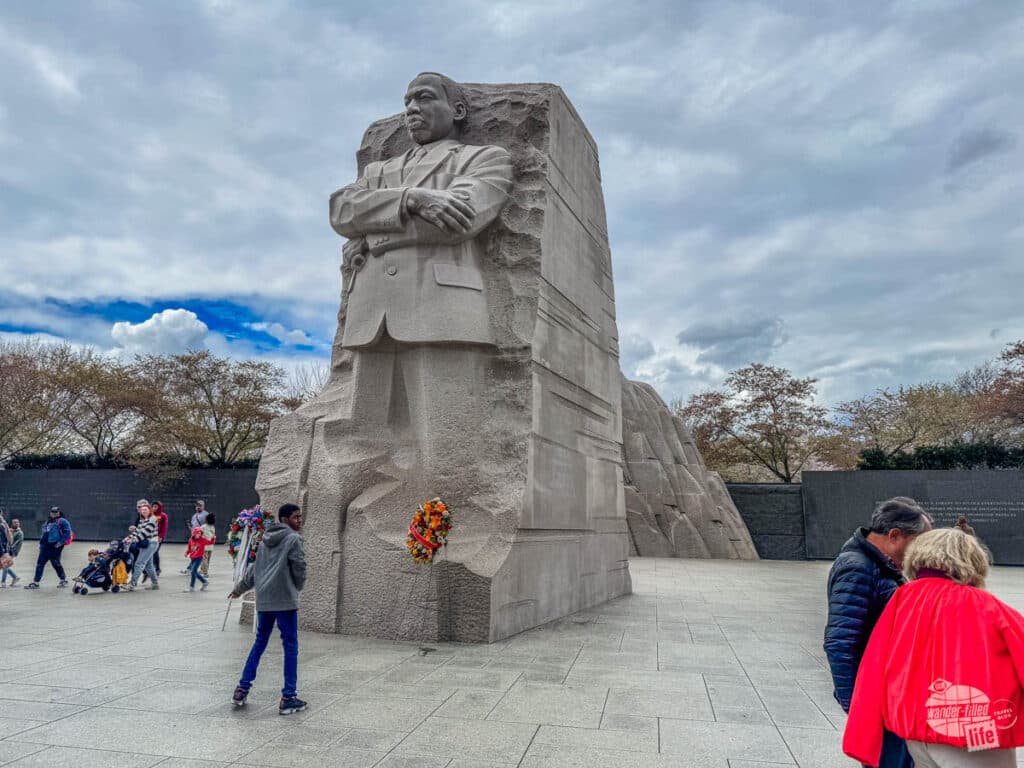
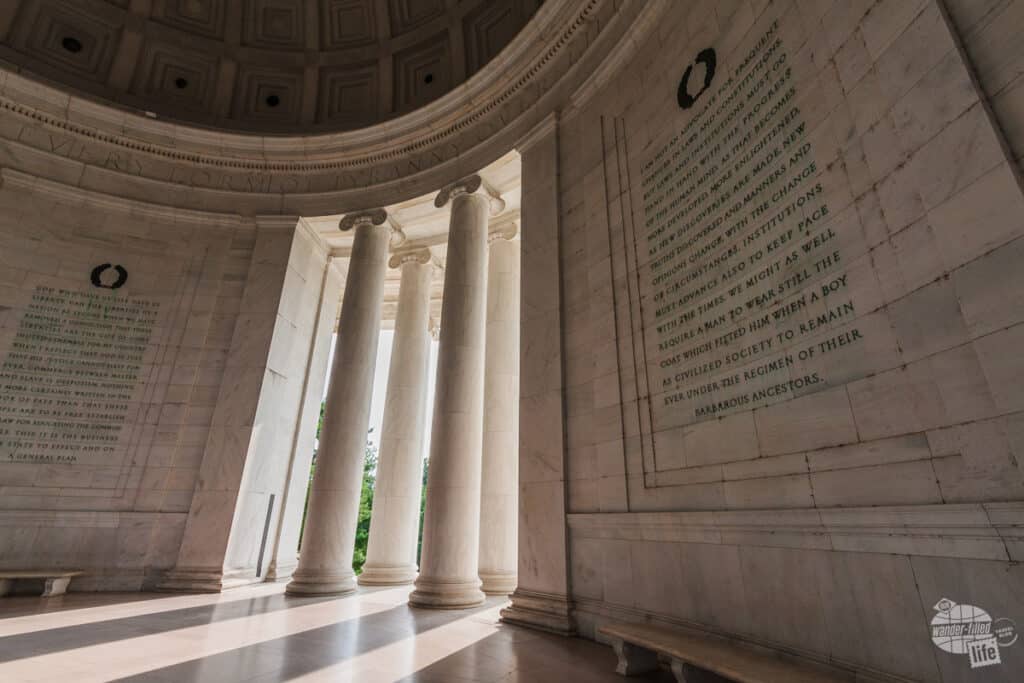
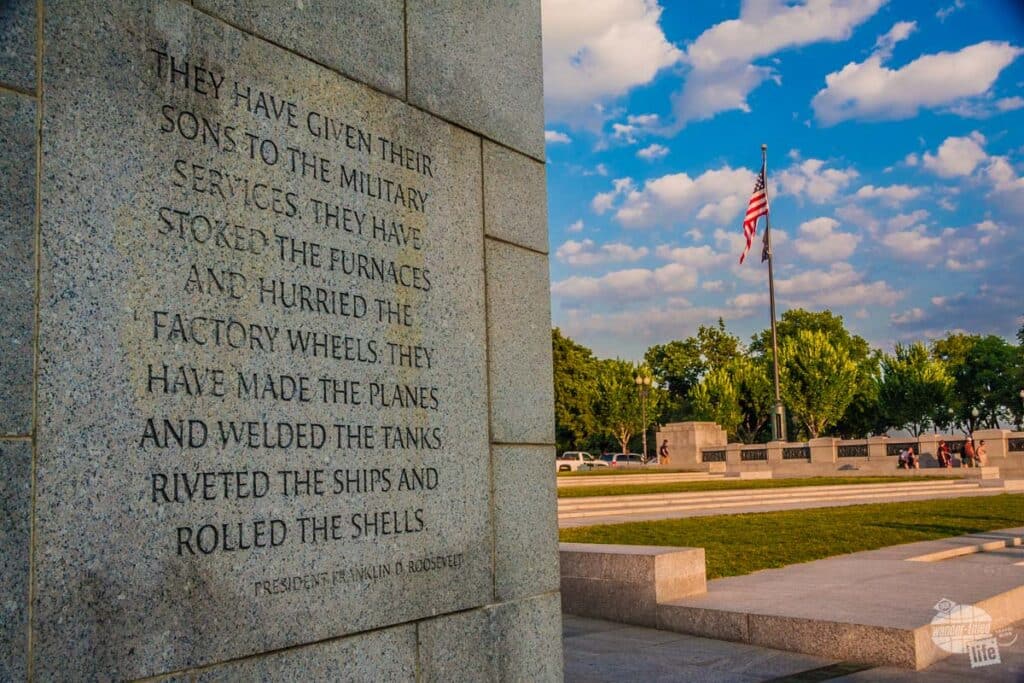
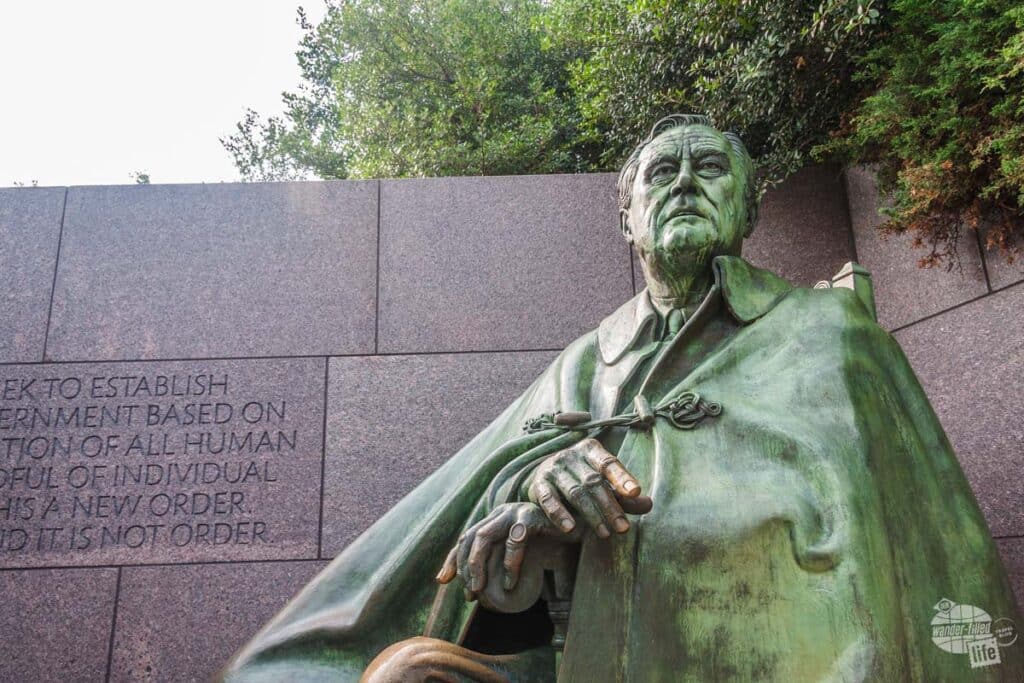
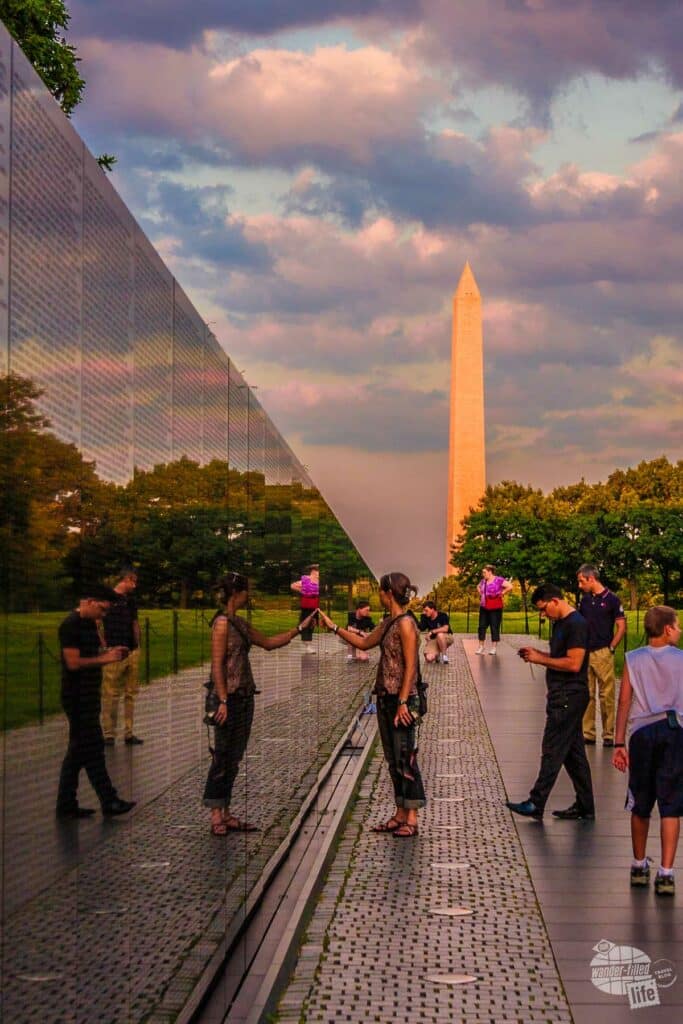
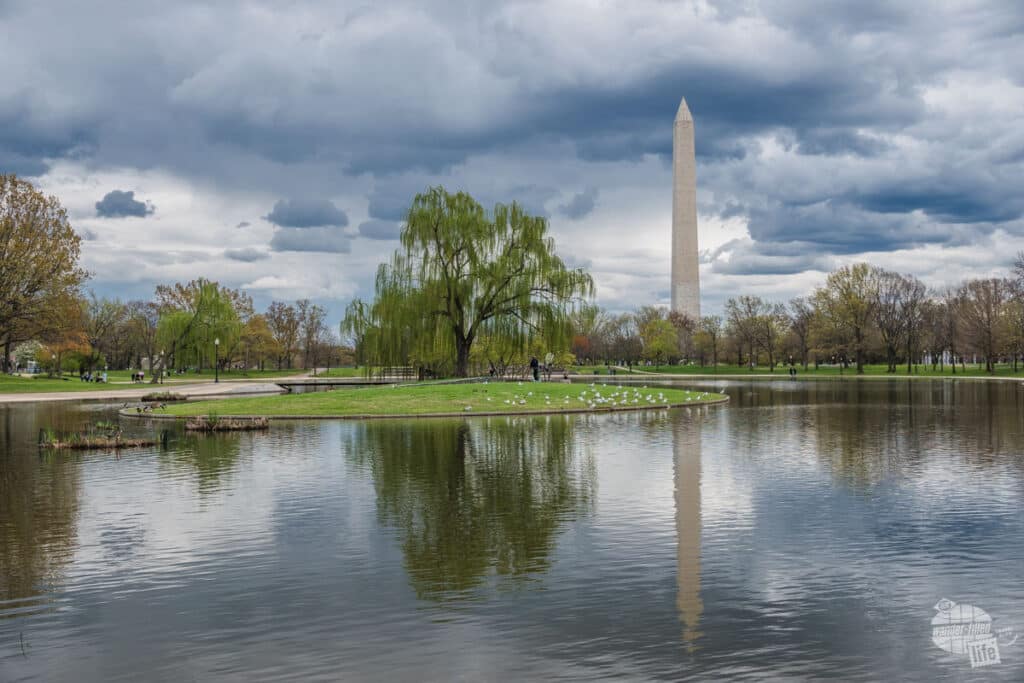
Some of these sites are quite spread out, so put on some walking shoes or grab a bike and just enjoy the day. There are maps and information booths scattered around, so finding your way around and seeing everything you are interested in shouldn’t be a problem, as long as you allot enough time.
The following parks can be found on the grounds of the National Mall:
- Constitution Gardens
- Franklin Delano Roosevelt Memorial
- Korean War Veterans Memorial
- Lincoln Memorial
- Martin Luther King, Jr. Memorial
- Thomas Jefferson Memorial
- Vietnam Veterans Memorial
- Washington Monument
- WWII Memorial
Each of these nine parks listed above counts as a park site on its own. The National Mall also counts as a park itself.
Of course, several other memorials fall under the jurisdiction of the National Mall and Memorial Parks do not count as parks on their own. These include the African American Civil War Memorial (which is located well north of the Mall), the American Veterans Disabled for Life Memorial and the District of Columbia War Memorial.
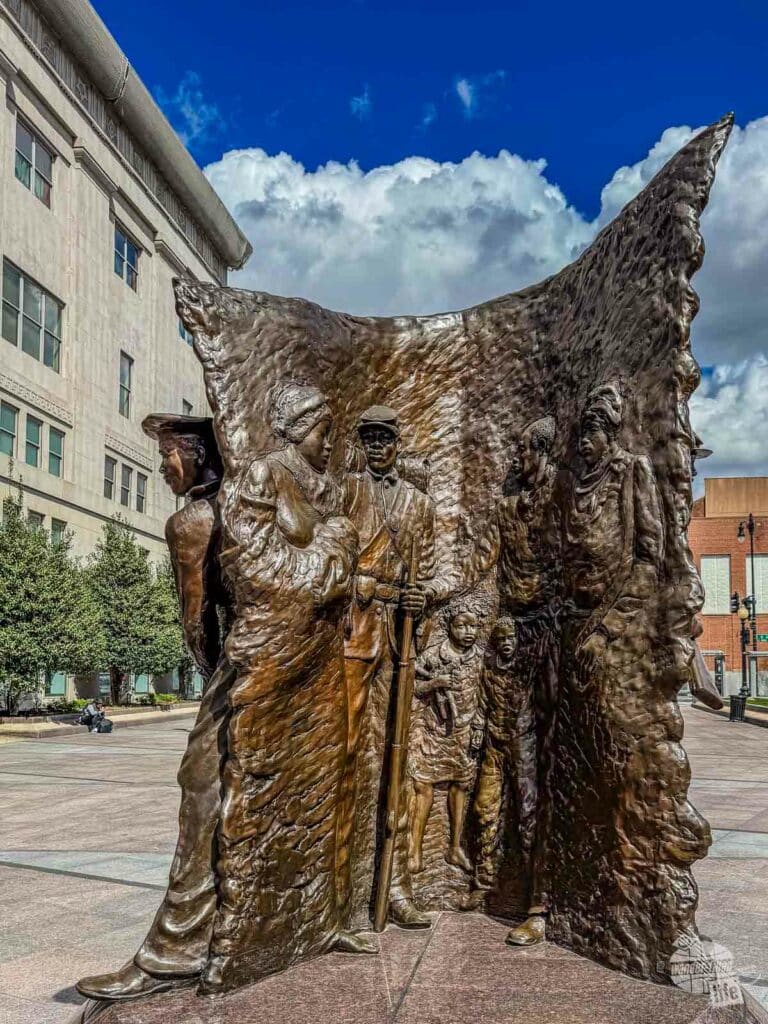
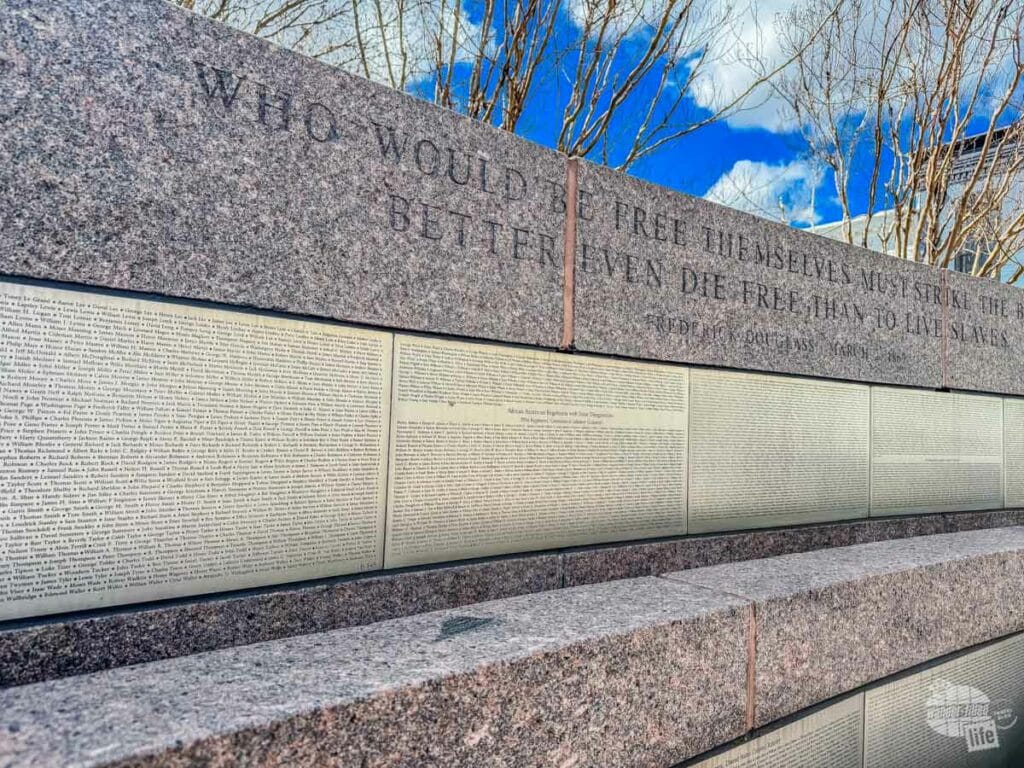
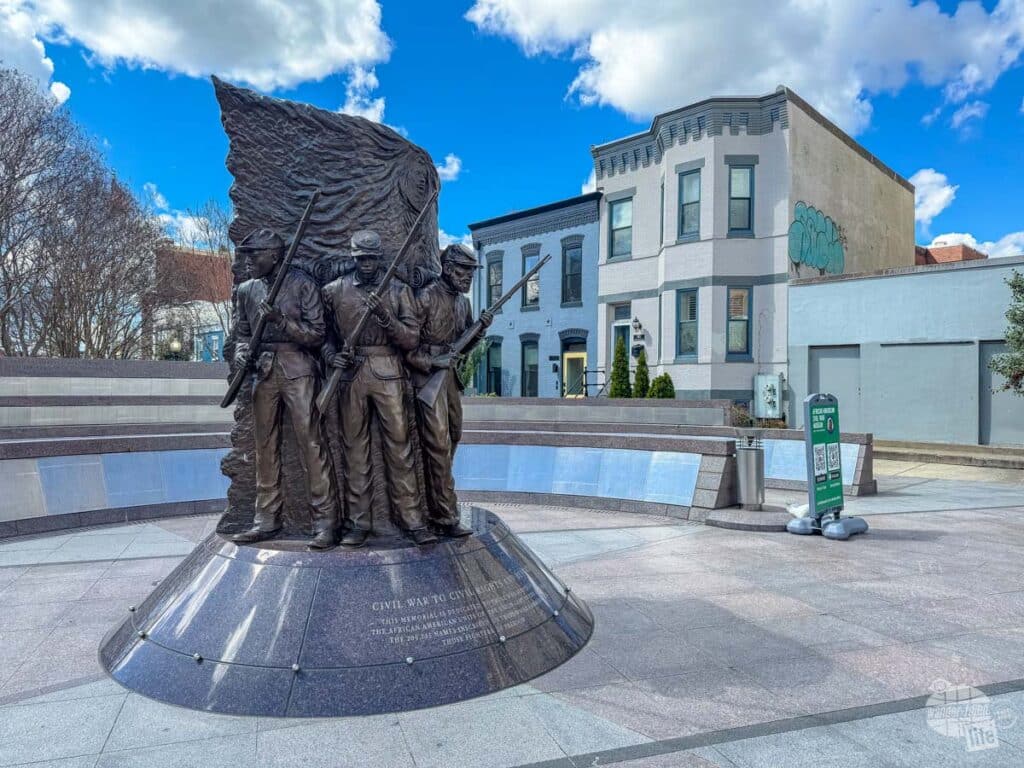
Touring the Washington Monument
Did you know that you can go inside the Washington Monument? Personally, we don’t think that you have to go inside to make your visit “count.” But, if you can get tickets, it’s pretty cool. Getting tickets for the Washington Monument isn’t easy, though, so be sure to plan ahead if it’s something you are interested in.
Advance tickets are available on recreation.gov and are released 30 days in advance at 10:00 am. For our Spring Break visit (first week of April), tickets sold out pretty much instantaneously two days in a row. We struck out the first day we tried. Thankfully, Grant was able to snag us two tickets on the second attempt.
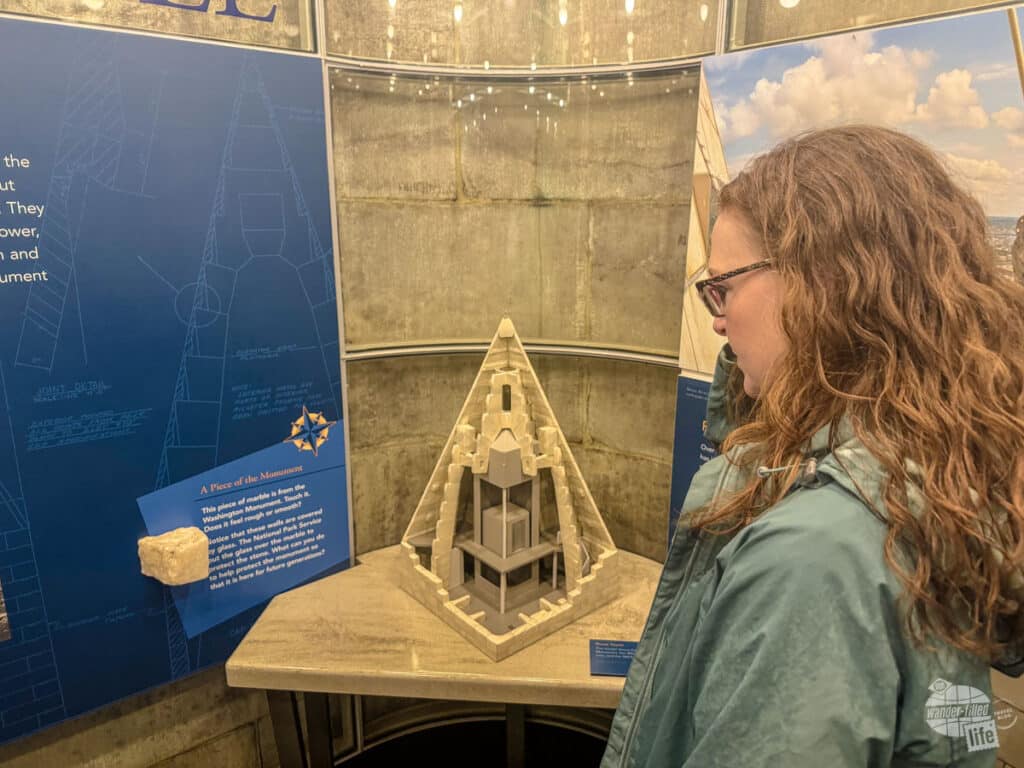
If you miss out on the first release, a limited number of tickets are released at 10:00 am for the next day’s visit. Additionally, same-day tickets are available in person at 8:45 am daily at the Washington Monument Lodge. Online information indicates that visitors often form a waiting line long before the ticket window opens.
Note: ticket distribution can change, so it’s always best to check the procedure in advance to confirm details.
If you are lucky enough to get tickets, pay attention to what you can and can’t take inside as you will have to pass through security. Once inside, an elevator takes you up to the viewing level at 500 feet. From here, you’ll have sweeping views of the city.
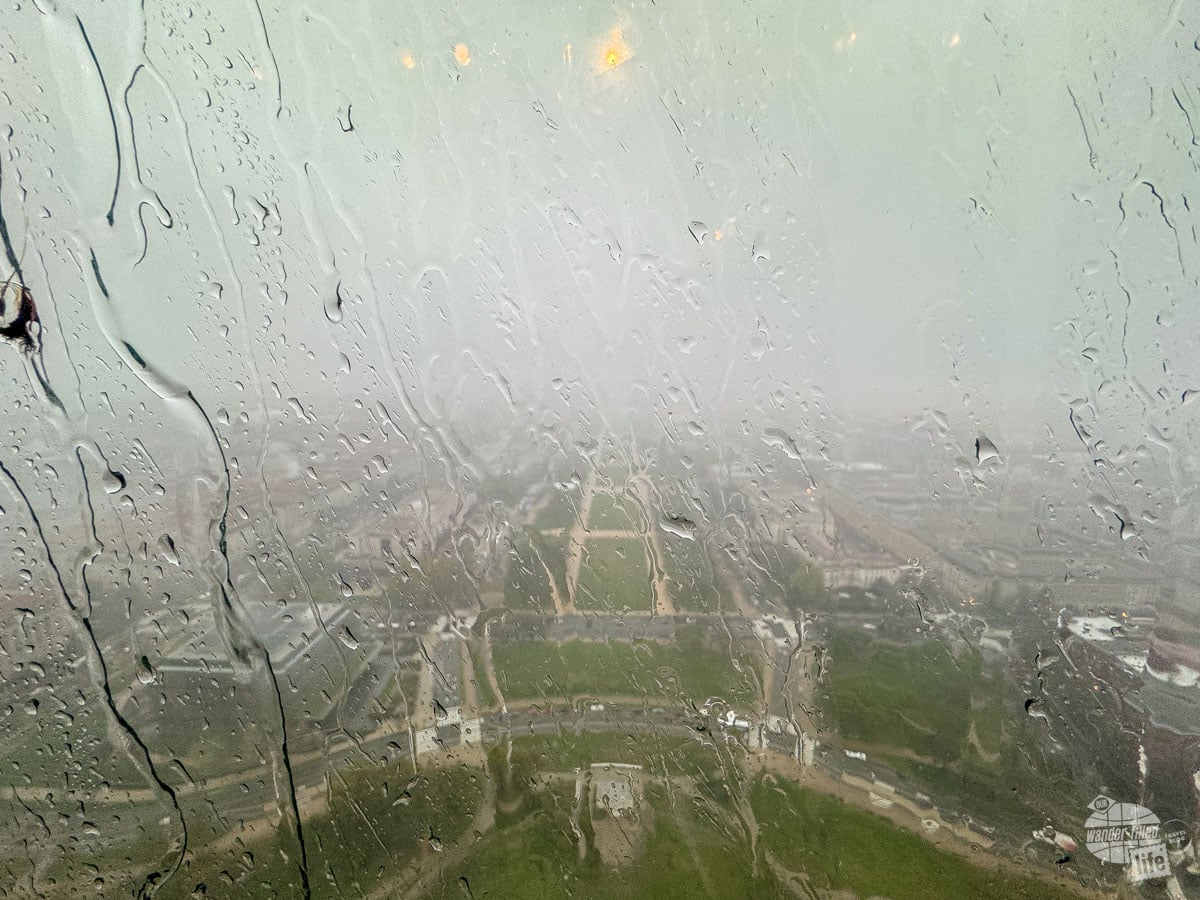
At least you should. If the weather doesn’t cooperate, it’ll be much less impressive. Alas, such was our experience. The day we visited the Washington Monument (and White House… more on that below) was a rainy, soggy mess.
Sadly, our “sweeping views of the city” were a rain-streaked window through which you could just barely make out the ground level below.
Still, it was a cool experience even if it was a wet, no-view mess.
Pennsylvania Avenue and the White House
Located just off the National Mall are two more national park sites: Pennsylvania Avenue and The White House & President’s Park.
In addition to viewing the White House (located at 1600 Pennsylvania Avenue) from the outside, you can visit the White House Visitor Center or apply for a tour of the White House.
The White House Visitor Center is located on the corner of 15th Street NW and E Street NW, just a block from the White House. It is free to visit without any sort of appointment, though you will have to pass through security.
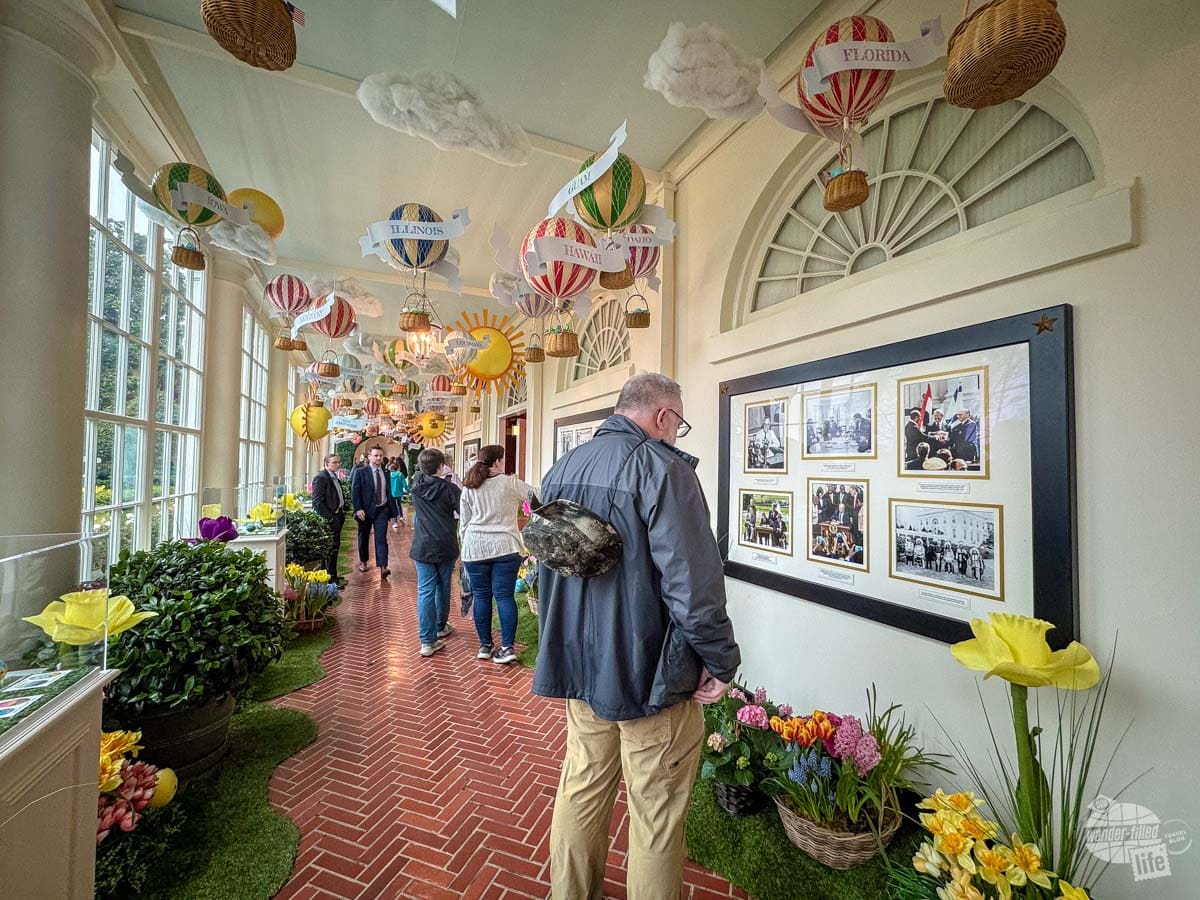
Inside, you’ll find a wide range of exhibits on both the political and residential nature of the White House. There is also a film about life in the White House. Regardless of your feelings on the current president, learning more about the White House, including its history and architecture is interesting.
To visit the White House, you’ll have to request a tour through your congressman or your senators. Foreign visitors can request a tour through their country’s Washington embassy. Tours are free of charge and typically available Tuesday – Saturday, excluding federal holidays.
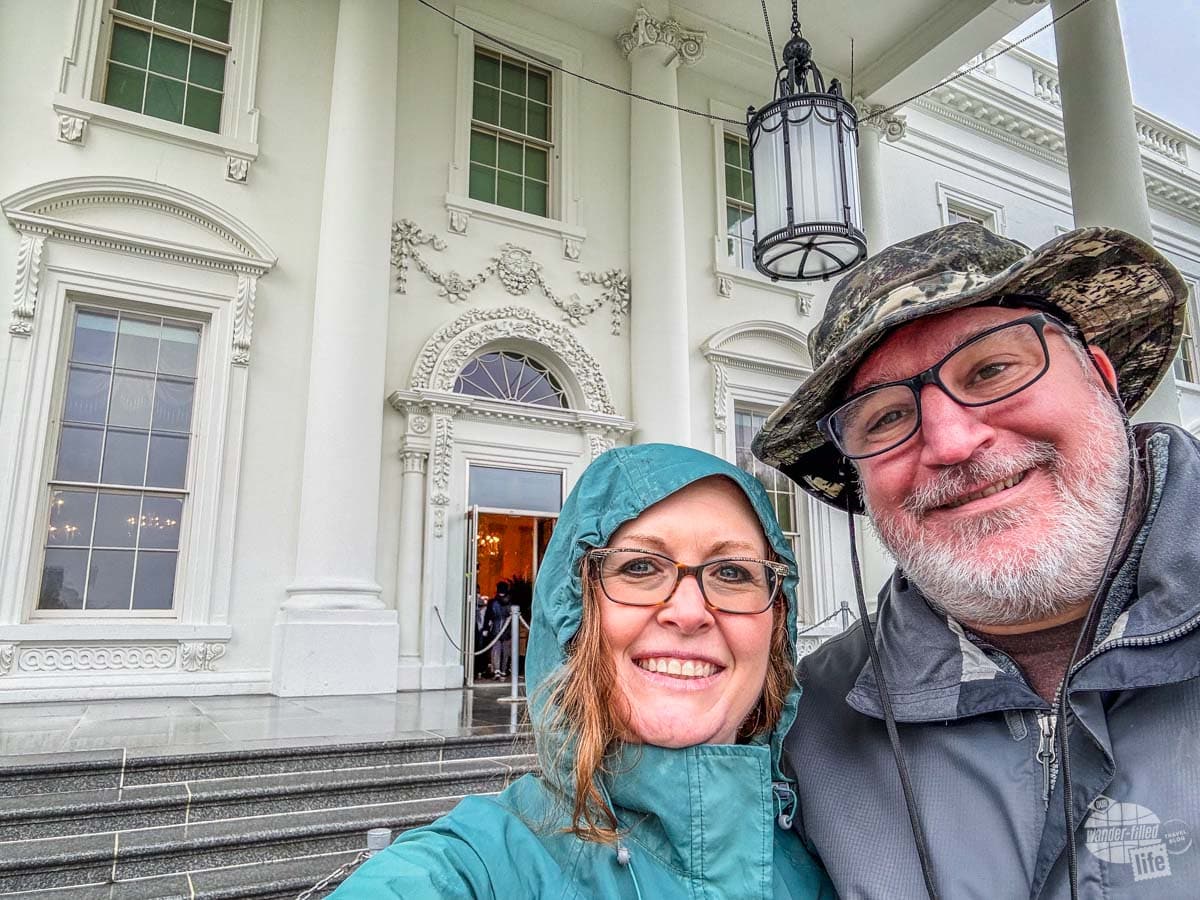
Requests can be made up to 3 months and no less than 21 days in advance. Tours are scheduled on a first-come, first-served basis, so we suggest submitting your request as early as possible, which is what we did. We were lucky enough to get a tour, though it wasn’t confirmed until just a couple of weeks before our trip.
Stay tuned for a separate article detailing our White House and Capitol Building tours.
Other National Parks Near the National Mall
The National Mall may not be the geographical center of Washington, DC but it is the heart of the city, so it should be no surprise that there are several other park sites near the Mall.
These include:
World War I Memorial – This site is both its own unit and part of the National Mall and Memorial Parks. It is located just east of the White House and honors those who fought and died in World War I.
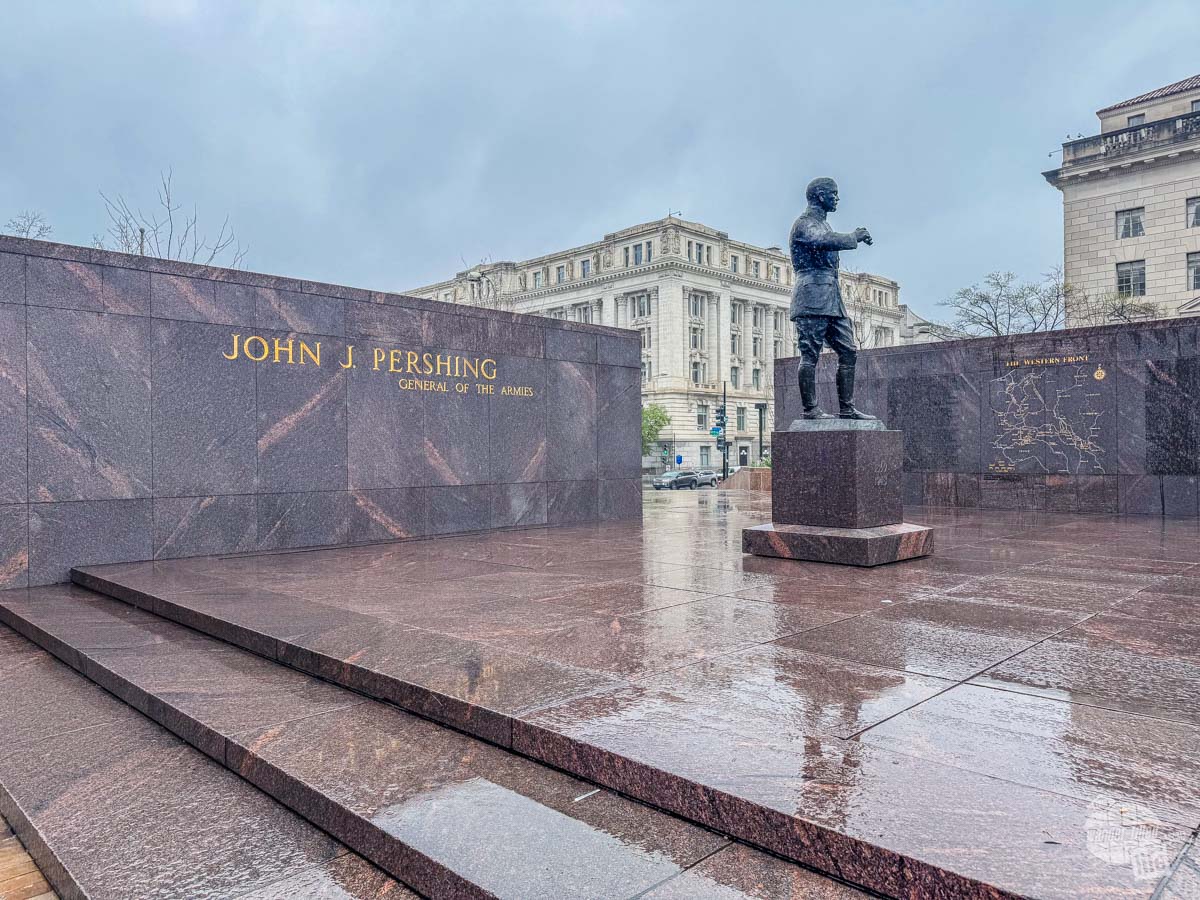
Ford’s Theatre National Historic Site – the site where President Lincoln was shot on April 14, 1865. Ford’s Theatre is still an active theatre but you can also take a tour ranger-guided tour. Tickets are available in advance for a small fee or for free on the day of your visit. We took the tour in 2011 and enjoyed the experience. It is well worth your time.
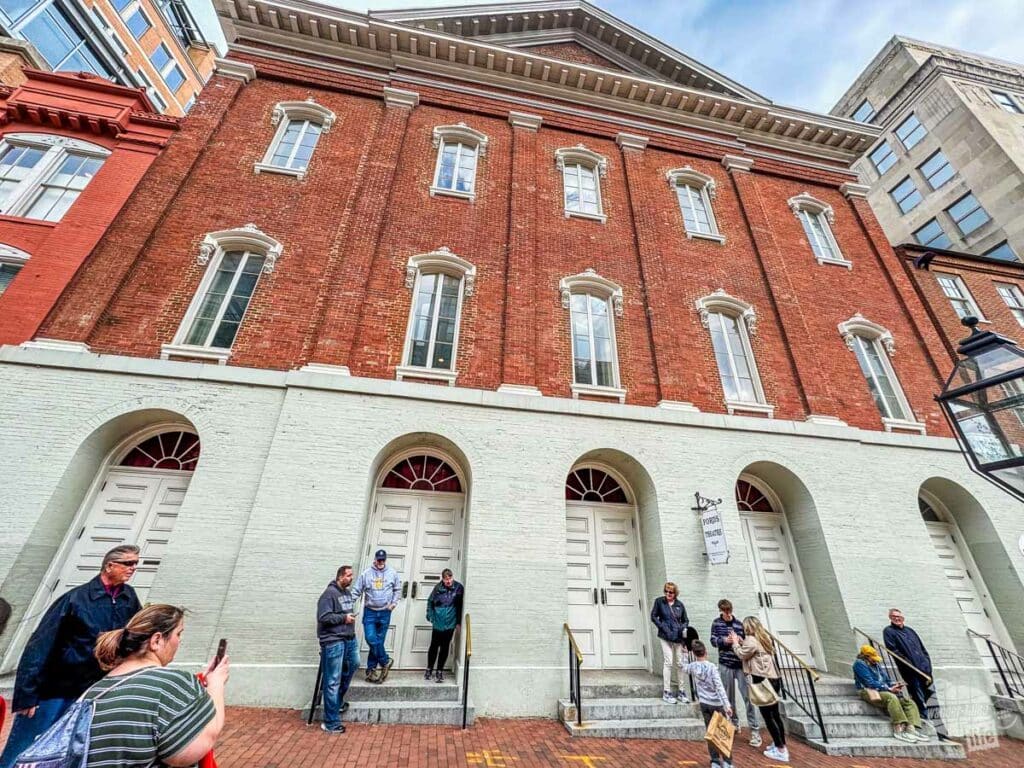
Dwight D. Eisenhower National Memorial – located a couple of blocks off the National Mall, across from the National Air and Space Museum, not far from the Capitol Building. This memorial honors Eisenhower’s contributions as the supreme commander of Allied forces in Western Europe during World War II and as President of the United States.
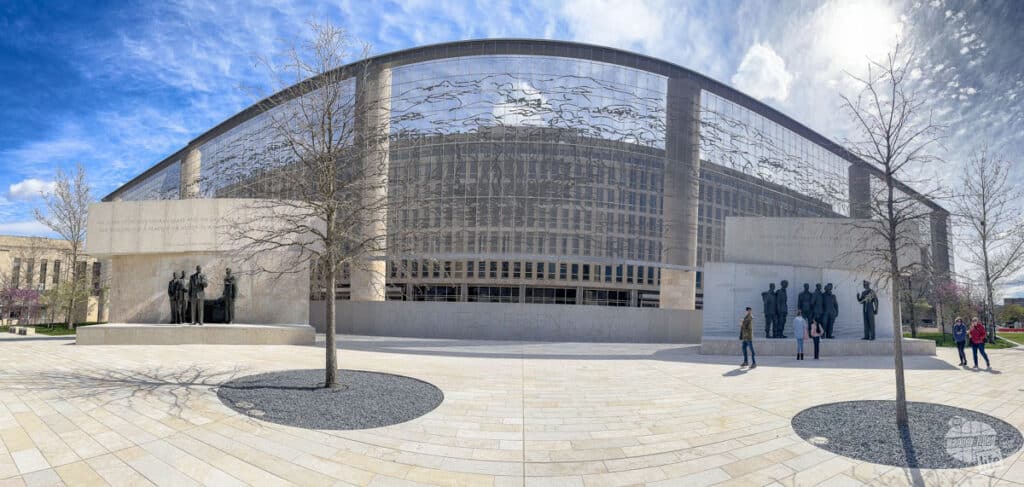
Belmont-Paul Women’s Equality National Monument – home to the National Woman’s Party for nearly 100 years. The house is located just a couple of blocks from the US Capitol and Supreme Court buildings. The site tells the story of the struggle for women’s rights. Ranger talks are given twice daily (no reservations required).
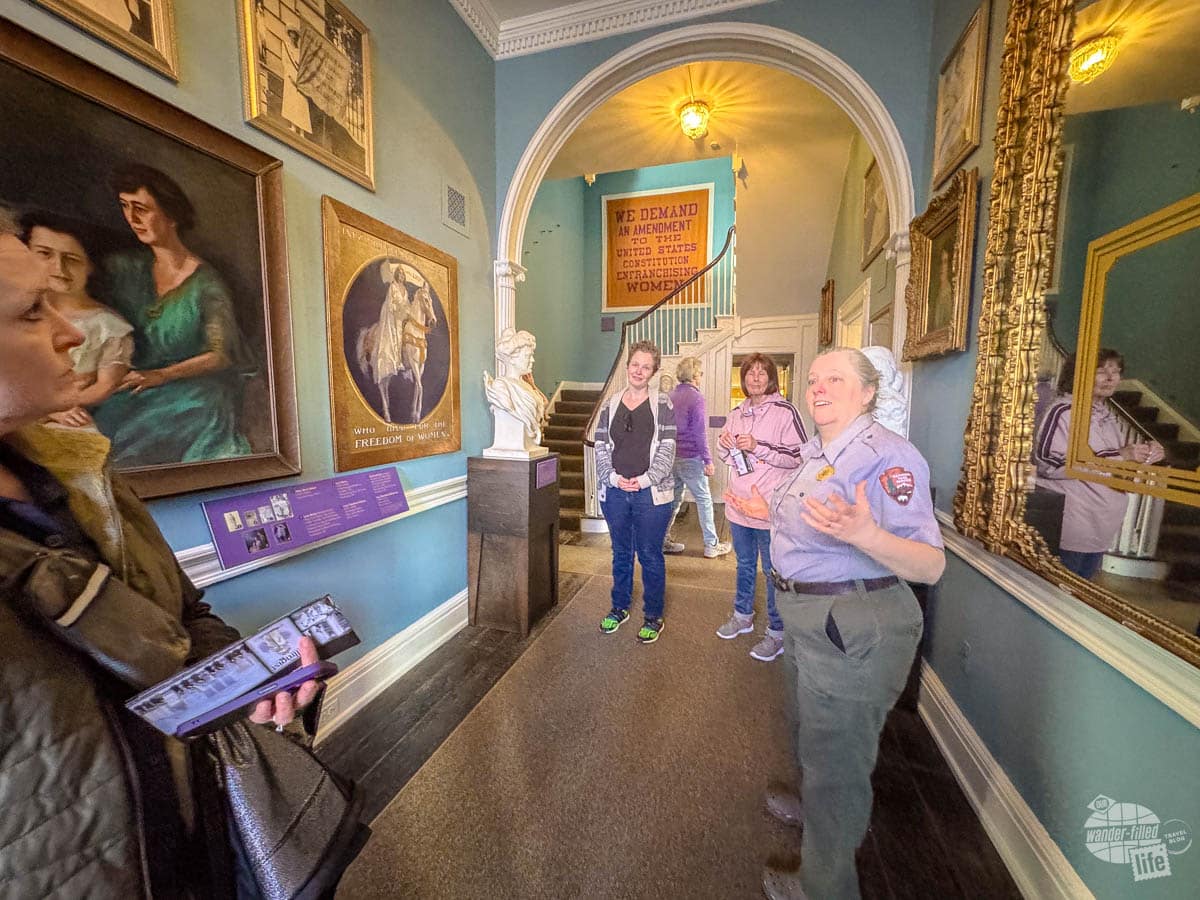
Another stop near the National Mall that you may be interested in is the Department of the Interior Museum. While this isn’t a national park site, it is a small museum in the building of the department that oversees the National Park Service.
The museum has a few exhibits on the importance of protecting our natural resources, along with artwork. You will have to pass through security when entering. The museum is free and can be seen in 30 minutes to an hour.
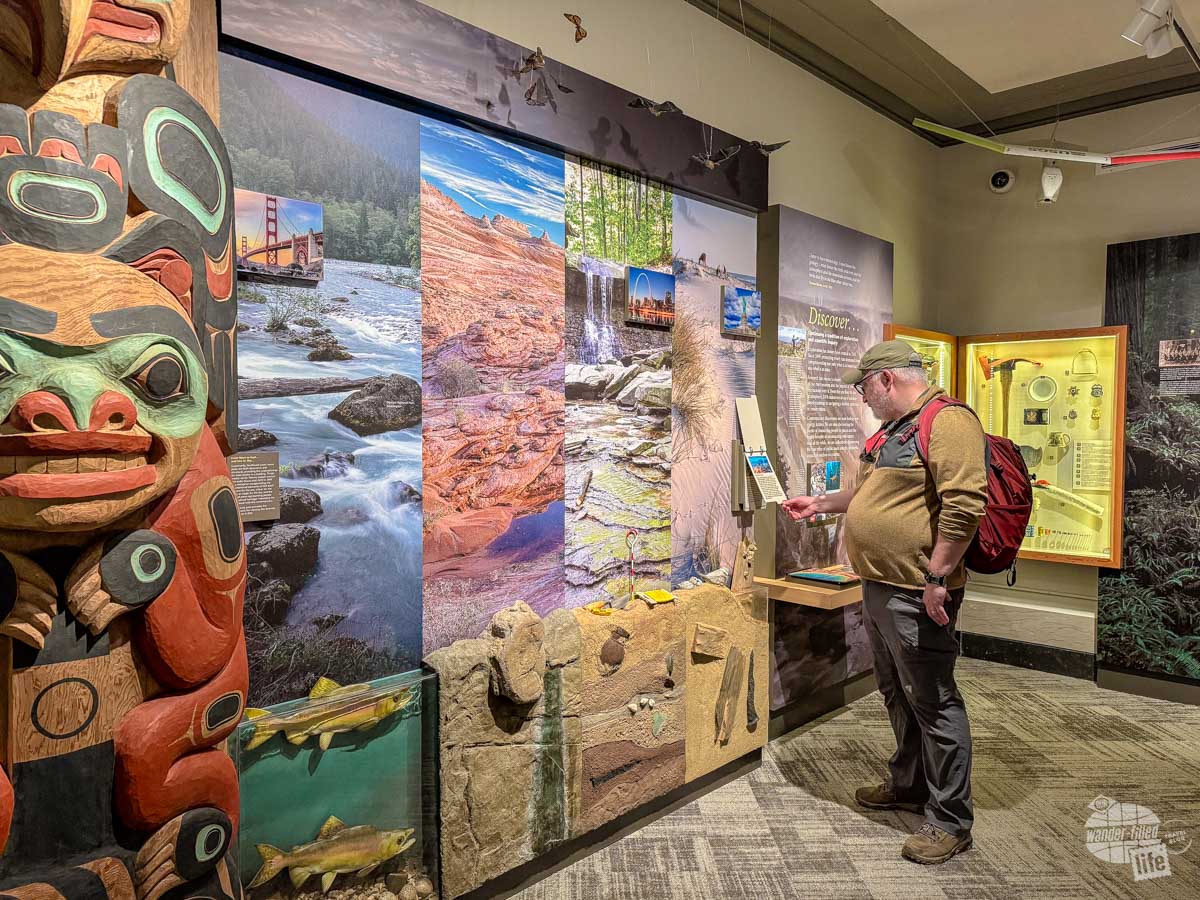
Other Park Sites Inside Washington, DC
About a mile north of the White House you’ll find two parks dedicated to two influential Americans:
Mary McLeod Bethune Council House National Historic Site – the townhouse that served as the first headquarters of the National Council of Negro Women and last residence of its founder, Mary McLeod Bethune. Guided tours are given every 30 minutes and tell the story of Ms. Bethune and her work.
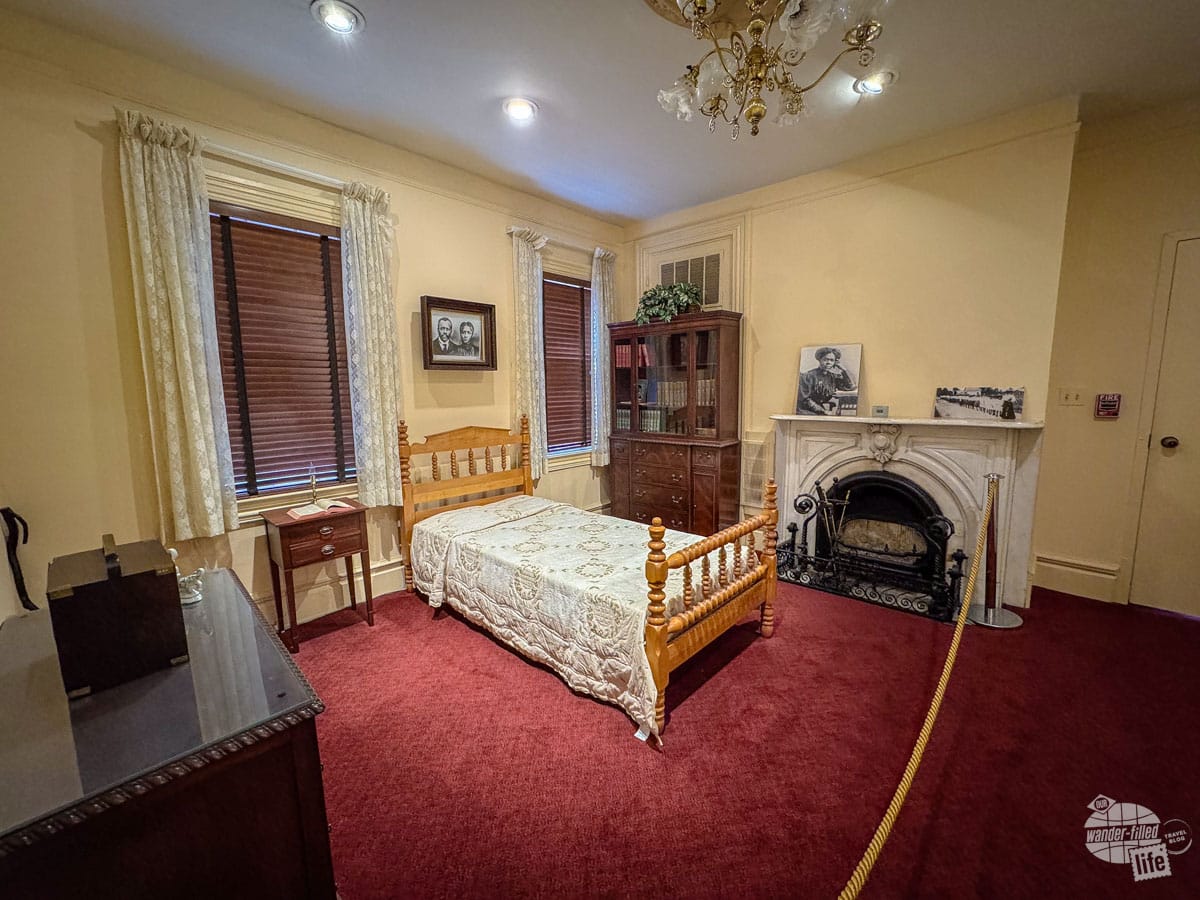
Carter G. Woodson Home National Historic Site – preserves the home of Dr. Carter G. Woodson, who is best known for starting the celebration of “Negro History Week,” which later expanded to become Black History Month. The site is currently undergoing renovations and is closed to the public.
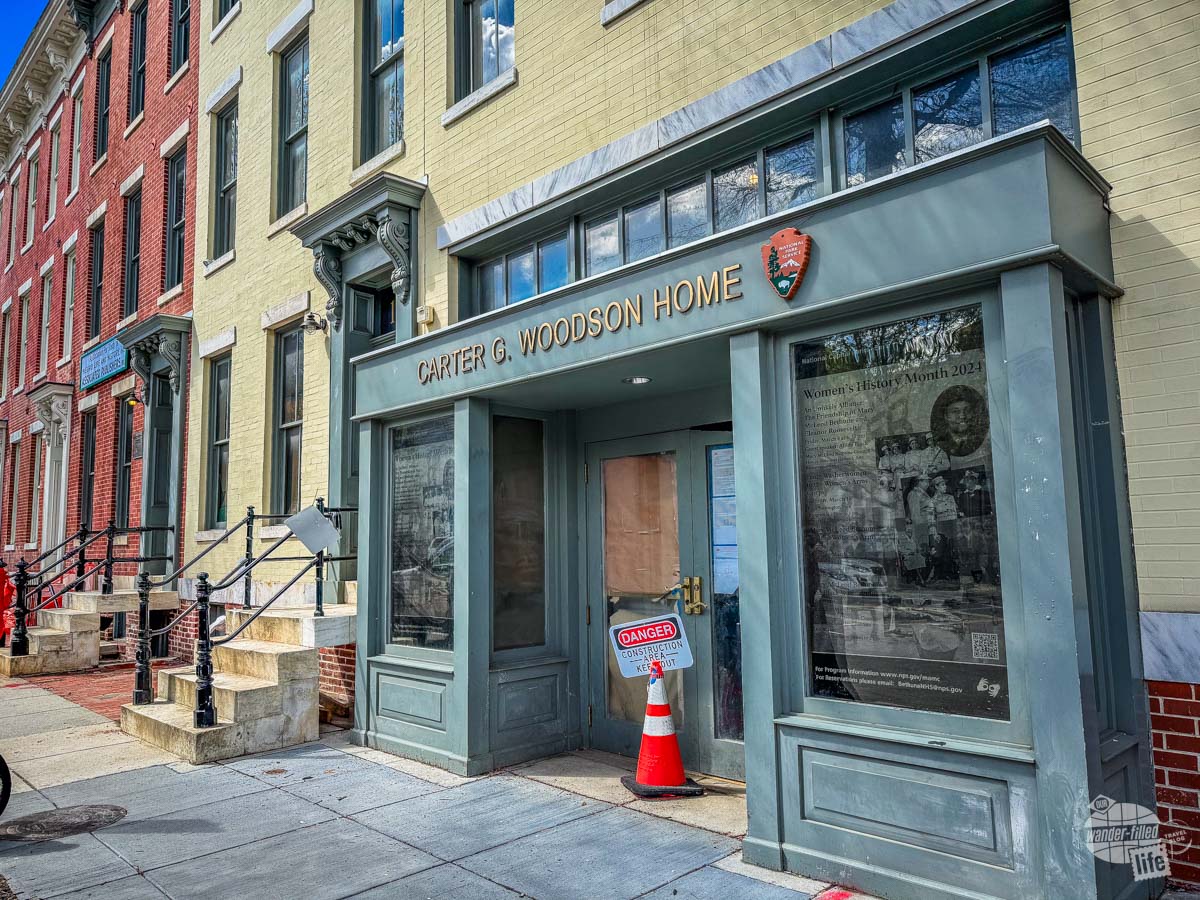
Unfortunately, the Woodson Home was closed during our visit in April 2024, so it remains as one of two Washington, DC area national parks that we have not visited. Our tour guide at the Council House said that the Woodson Home is projected to open in Fall 2024. Be sure to check the park’s website and social media for up-to-date information before planning a visit.
Getting Around Washington, DC
Driving and parking in Washington, DC is not necessarily easy. When visiting the National Mall and other sites in Downtown DC, we recommend taking the metro or some other form of public transportation and walking between sites that are close together.
All of the sites above can easily be reached from several different metro stations. Additionally, buses run through the city if you are limited in how much you can walk.
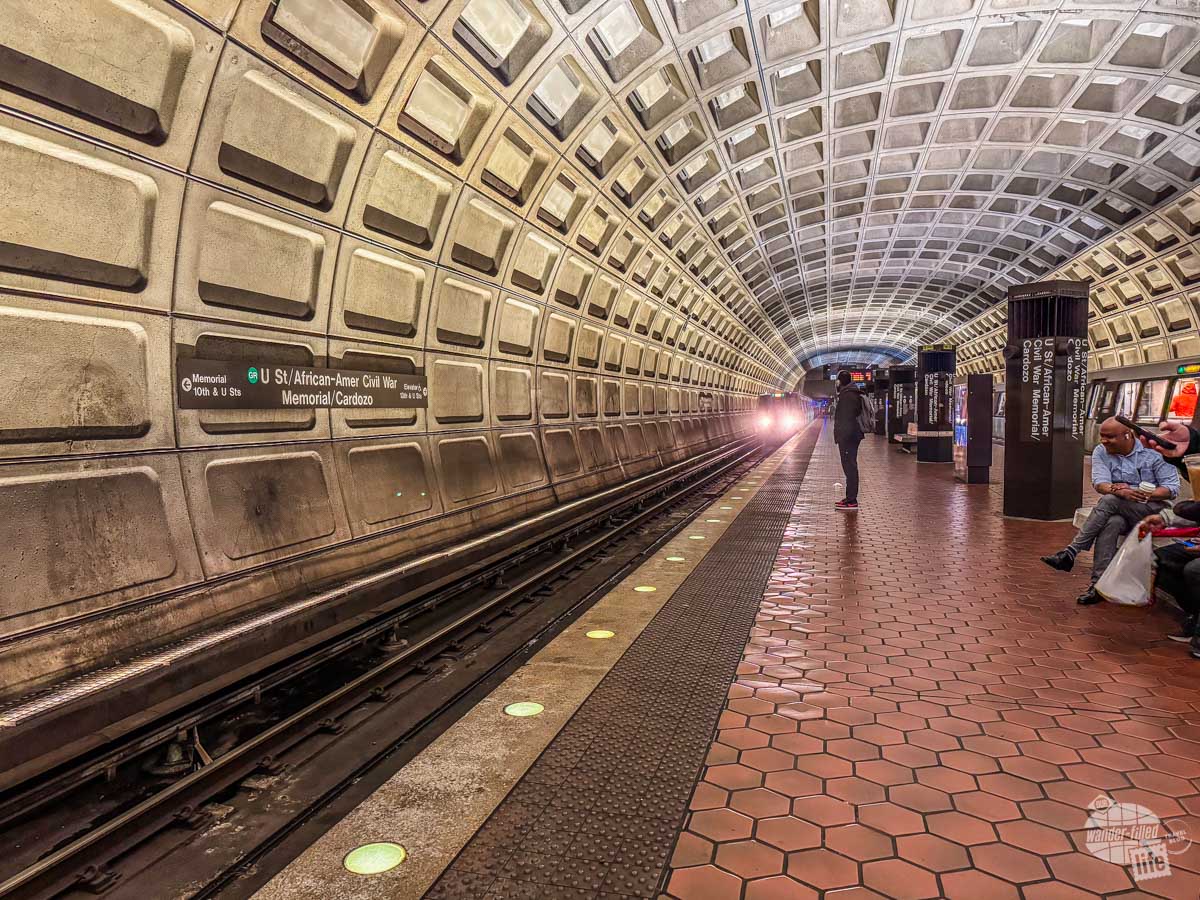
Once you get outside the downtown area, you’re more likely to want a car. We drove to all of the parks that are listed below.
A few can be reached via bus if you don’t have a car. But some will require having a car. Check each park’s “Directions & Transportation” page for information on public transportation. On the park’s official NPS website, this is generally located under the “Plan Your Visit” dropdown menu right under the park’s name.
Many of these parks fall into the “Other Designations,” meaning they are not designated as National Parks, National Monuments, National Historic Sites or any of the other “standard” park types. It’s interesting to me that all of the 11 parks in this category are in the Washington, DC area.
Southeast DC: Frederick Douglass NHS & National Captial Parks – East
On the southeast side of Washington, DC, the easiest park to visit is the Frederick Douglass National Historic Site.
This park preserves the final home of Frederick Douglass, who was born into slavery, eventually escaping and becoming a leader for equality and abolition. The focus of the park is Douglass’ home, Cedar Hill, which can only be seen on a ranger-guided tour.
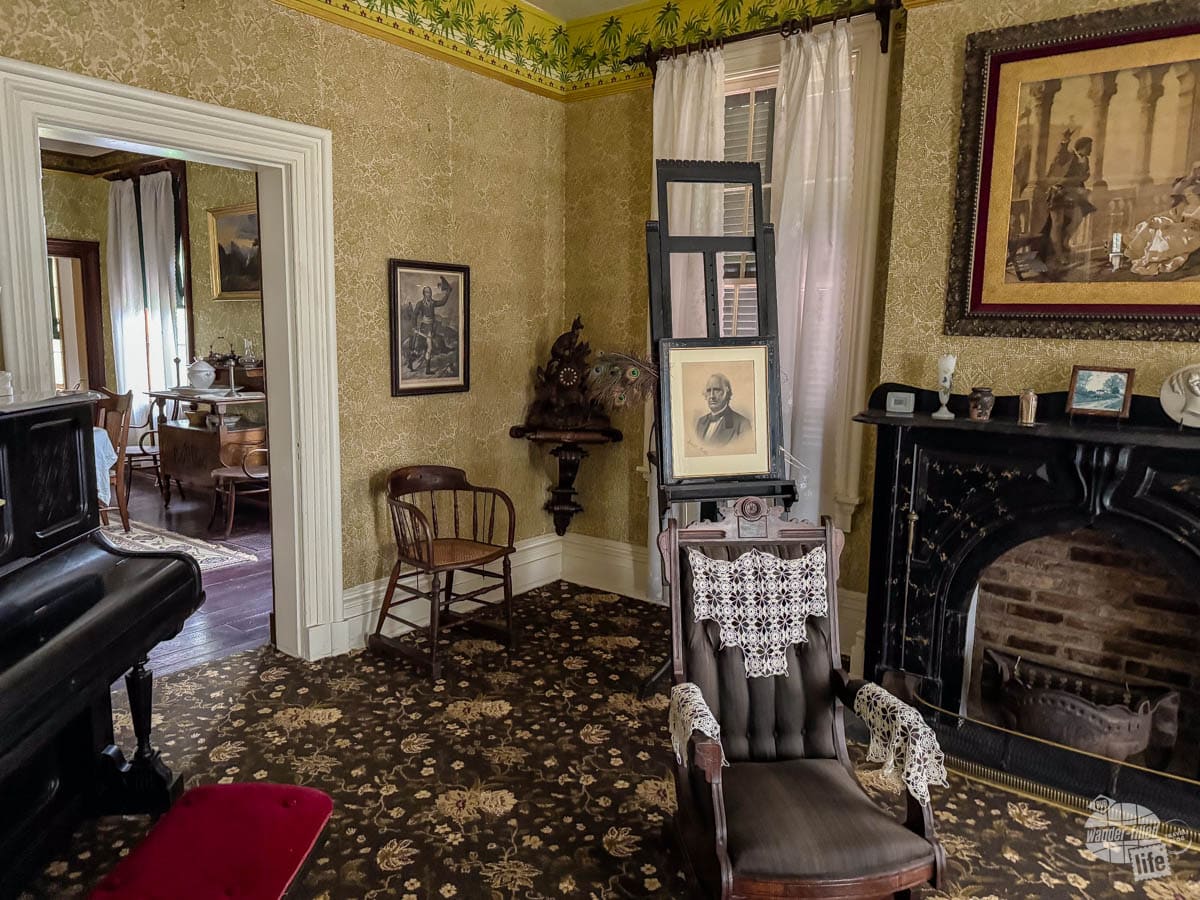
Tour reservations are recommended and can be made through recreation.gov for a small fee.
Near Frederick Douglass NHS, you’ll find a few of the units that make up National Capital Parks – East, including Anacostia Park and Oxon Cove Park & Oxon Hill Farm.
Anacostia Park is a waterfront park along the Anacostia River. I’m sure it’s lovely when the weather is nice but it was a little cool and rainy during our visit. Mostly, it is just a place for locals to enjoy the outdoors. So, we snapped a few pictures and moved right along.
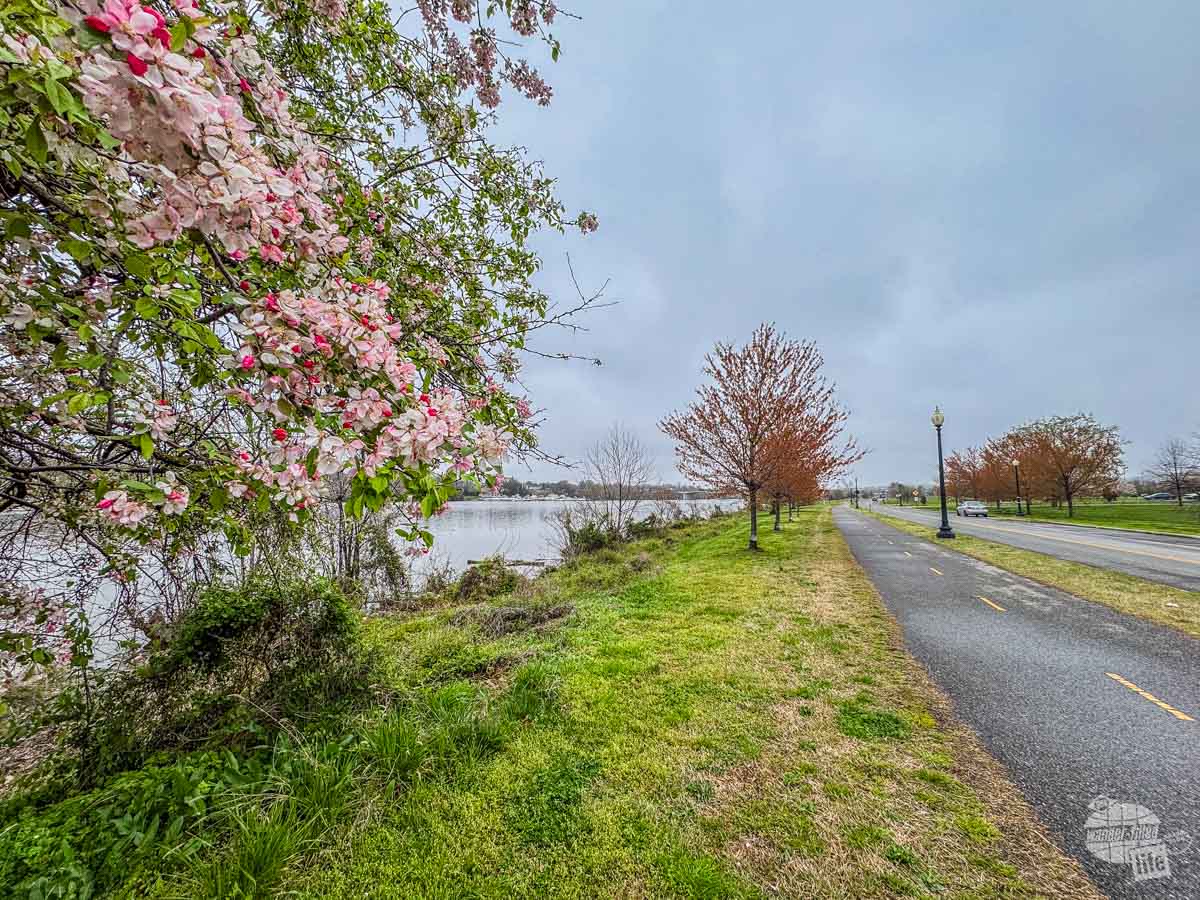
Oxon Hill Farm is just that – a working farm with cows, goats, chickens, hogs and more. You can wander through the grounds to visit the animals and enjoy the outdoors. There are several historic barns that you can tour. The farmhouse, which dates back to around 1811 is currently used for the park’s administrative offices. We spent about 30 minutes wandering the grounds. If you have nice weather or are visiting with children, you could probably spend longer here.
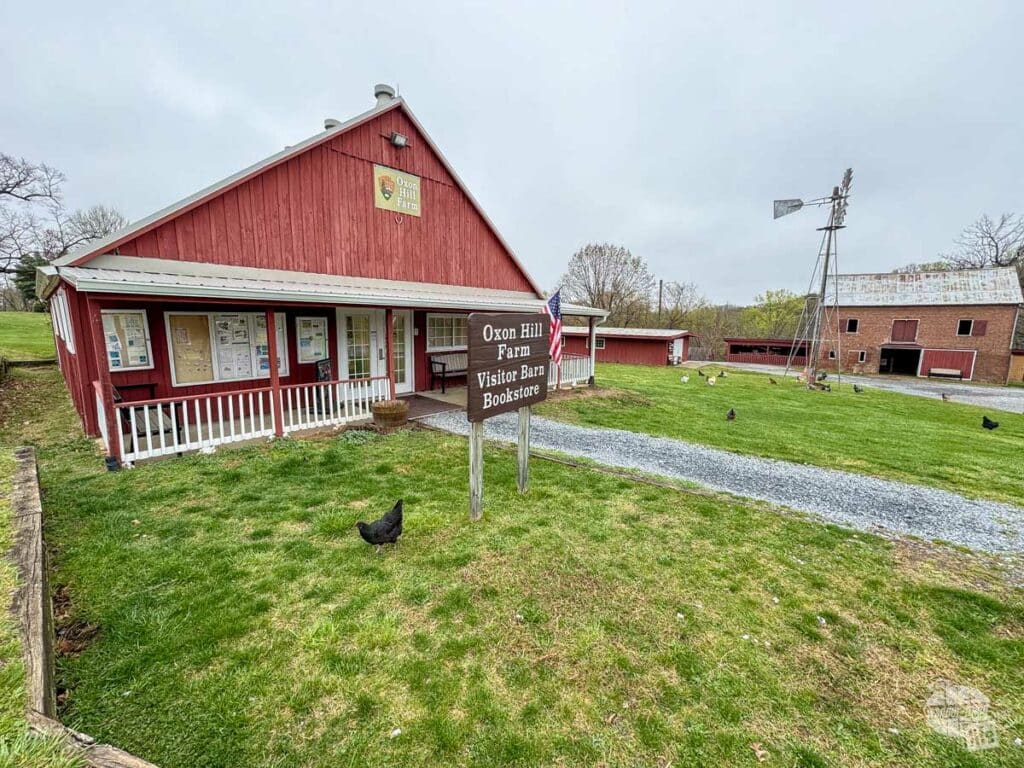

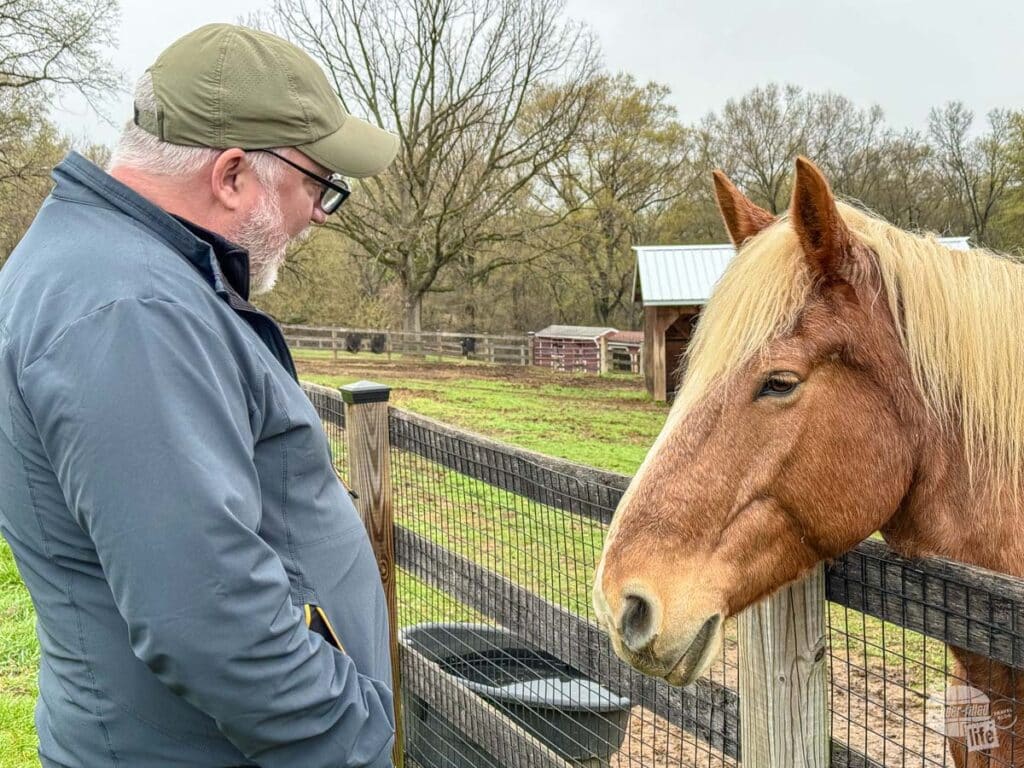
There are a few other parks managed by National Capital Parks – East if you have more time and want to extend your visit. Several of these are just small, local parks. A few of these are official NPS parks and are listed below.
Northern DC: Rock Creek Park
Covering more than 1700 acres, Rock Creek Park was authorized in 1890, making it the third “national park.” Honestly, though, it’s just a “city park” for the residents of Washington, DC to escape the hustle and bustle of the city and find a little nature.
Rock Creek is a great place for a walk or run on one of the many trails. There also are a few Civil War fortifications, historic buildings and statues. Be sure to check the “Places to Go” on the park’s website for a complete list of notable destinations inside the park.
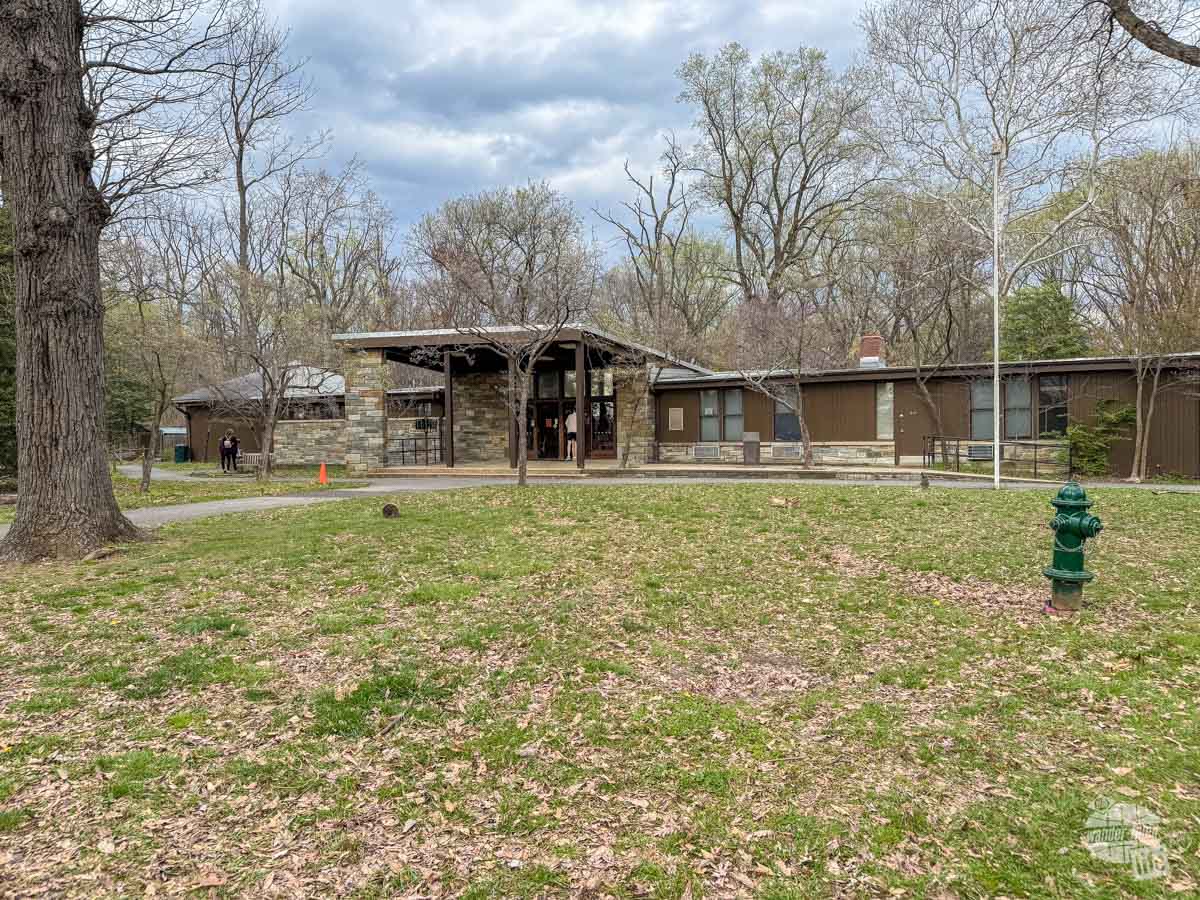
Unfortunately, we arrived just after the Nature Center, which is also the main visitor center, closed for the day. So, we just walked down to the earthwork remains of Fort DeRussy, which was an easy 10-minute walk from the Nature Center parking lot.
The next day, we stopped at the Old Stone House, located in Georgetown. It is the oldest structure on its original foundation in Washington, DC and now serves as a visitor center and bookstore. There are a few exhibits set up in the very small original kitchen. Honestly, we were really hoping for more. Still, it’s a neat stop and definitely historic if you have the time to stop.
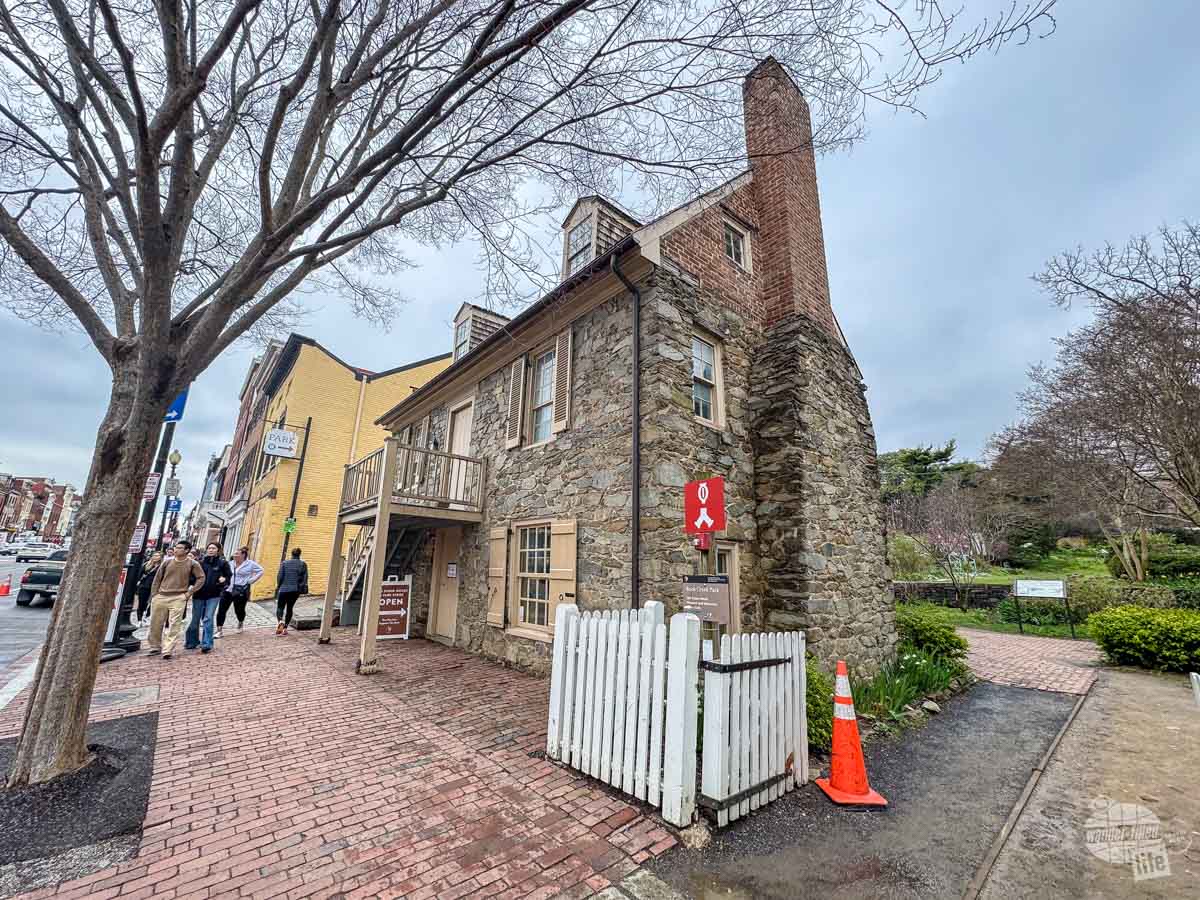
For us, Rock Creek Park was a little frustrating. We can almost always find value in even the smallest and most obscure national park sites. Rock Creek Park truly is just a local park that happens to be in the nation’s capital and under the management of the National Park Service.
If you’re looking to visit all 400+ national park sites, you have to make at least a quick stop for a hike. Otherwise, it’s probably not worth your time.
George Washington Memorial Parkway
Stretching north-south, mostly along the western bank of the Potomac River, the George Washington Memorial Parkway is more than just a roadway. It includes and connects several small parks and historic areas.
A few of the notable stops along the parkway include Dyke Marsh Wildlife Preserve (where we saw a couple of nesting Bald Eagles), Glen Echo Park (a historic amusement park) and Great Falls Park (where you’ll find a dramatic gorge and waterfall).
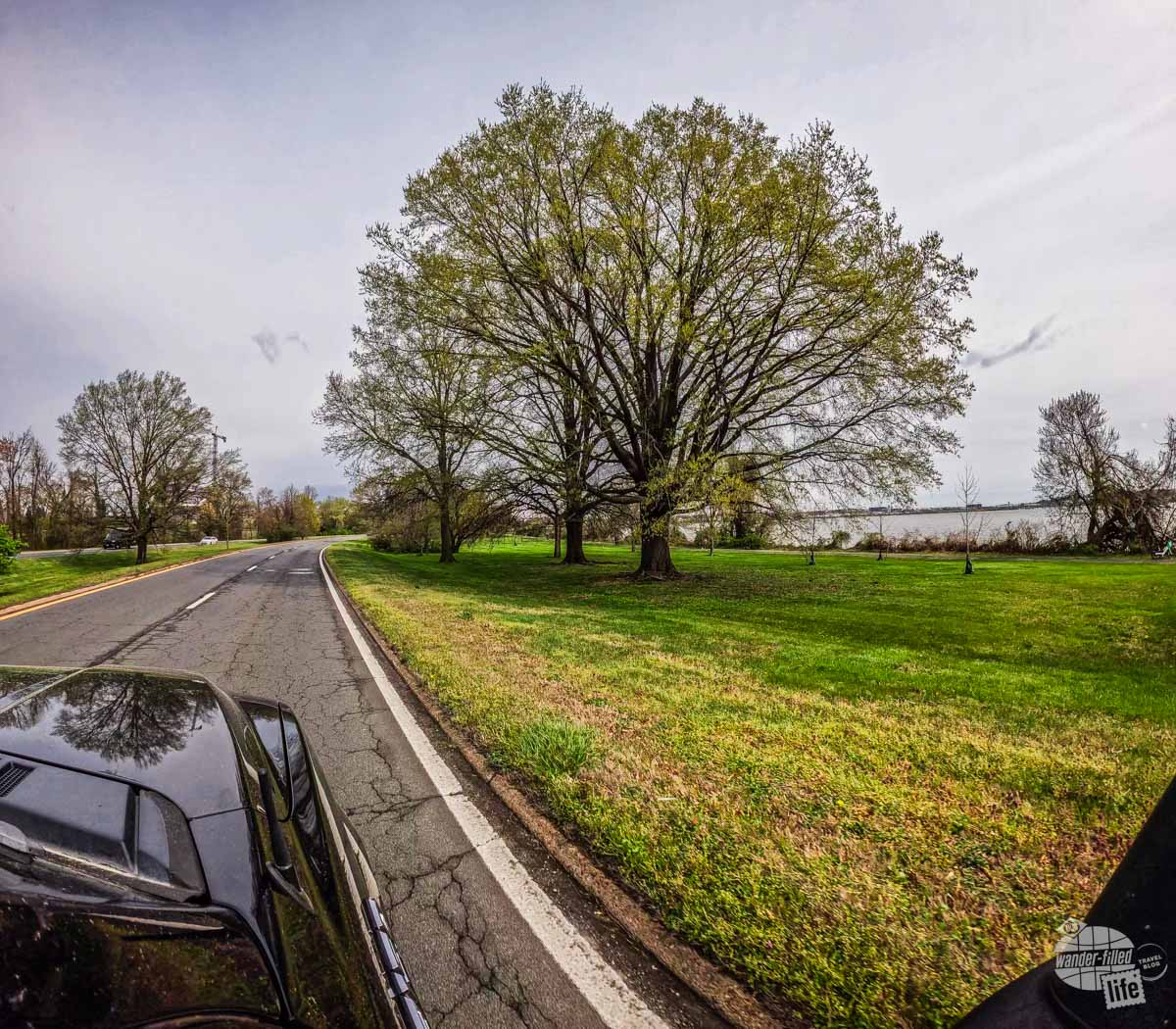
Great Falls Park is the highlight of this park and could easily be its own park site. There, you’ll find several different viewing platforms for the dramatic waterfall. It also has an array of hiking trails and a huge picnic area.
We visited Great Falls Park in the late morning on Easter Sunday. It was a nice day early Spring day with mild temperatures. As such, the park was packed with families enjoying the outdoors and visitors marveling at the waterfall.
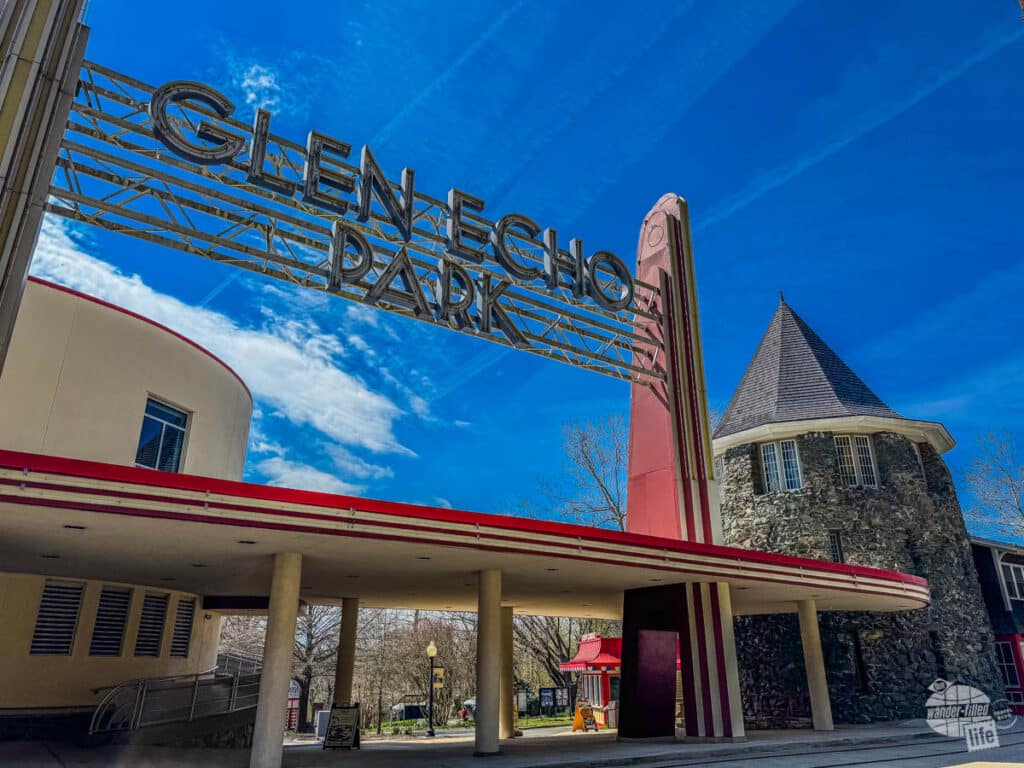
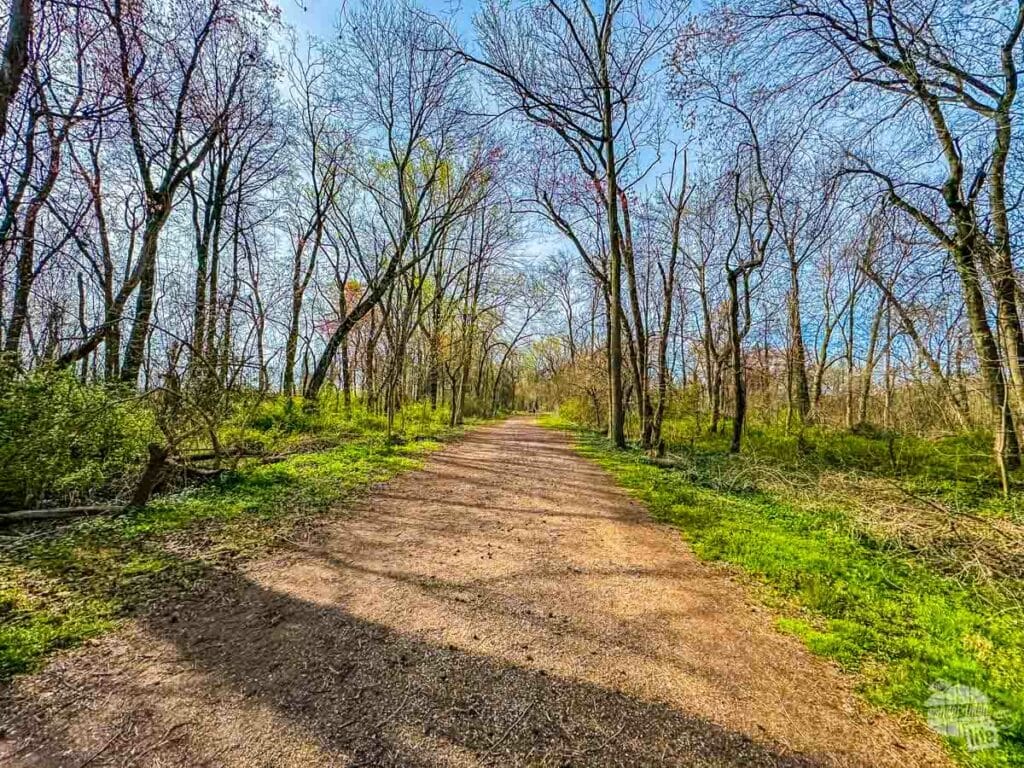
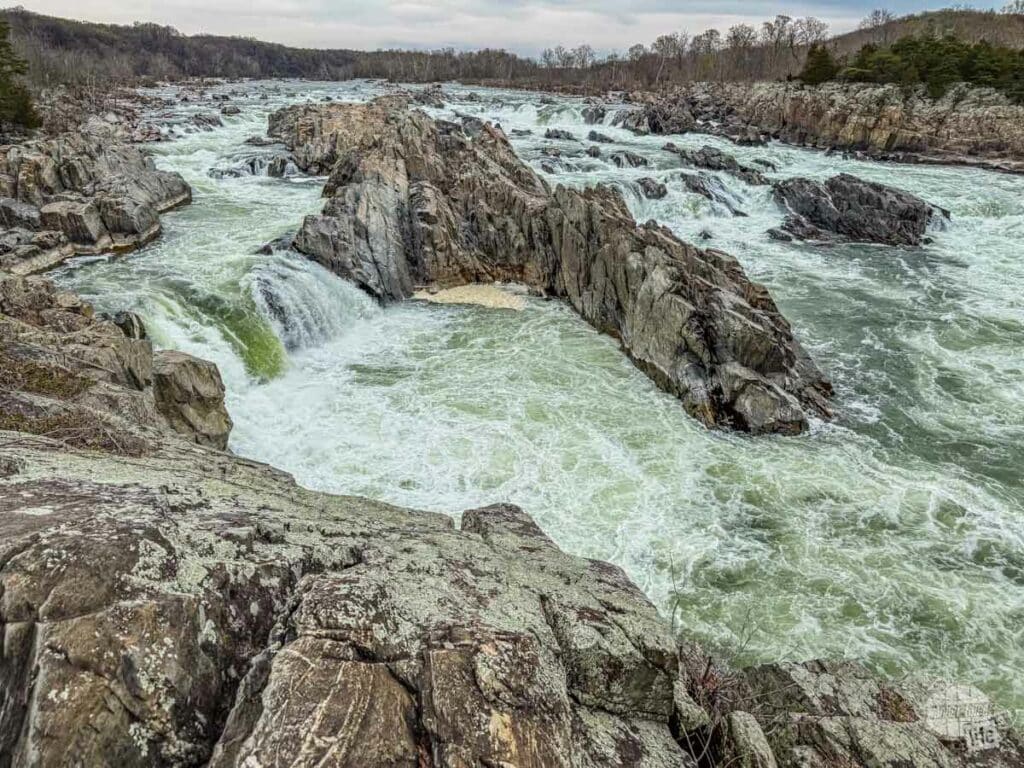
Truly, Great Falls Park is worth the drive outside the city to view the stunning landscape. It’s worth noting, though, that cell phone service is essentially non-existent inside the park even though it’s only 20-30 minutes north of downtown Washington, DC.
Other Park Sites On or Near George Washington Memorial Parkway
The parks below are located along the George Washington Memorial Parkway and also count as parks on their own.
Theodore Roosevelt Island – a small island with trails and a large memorial to President Theodore Roosevelt. This is a great place to stretch your legs and reflect on all that Roosevelt did for the national parks.
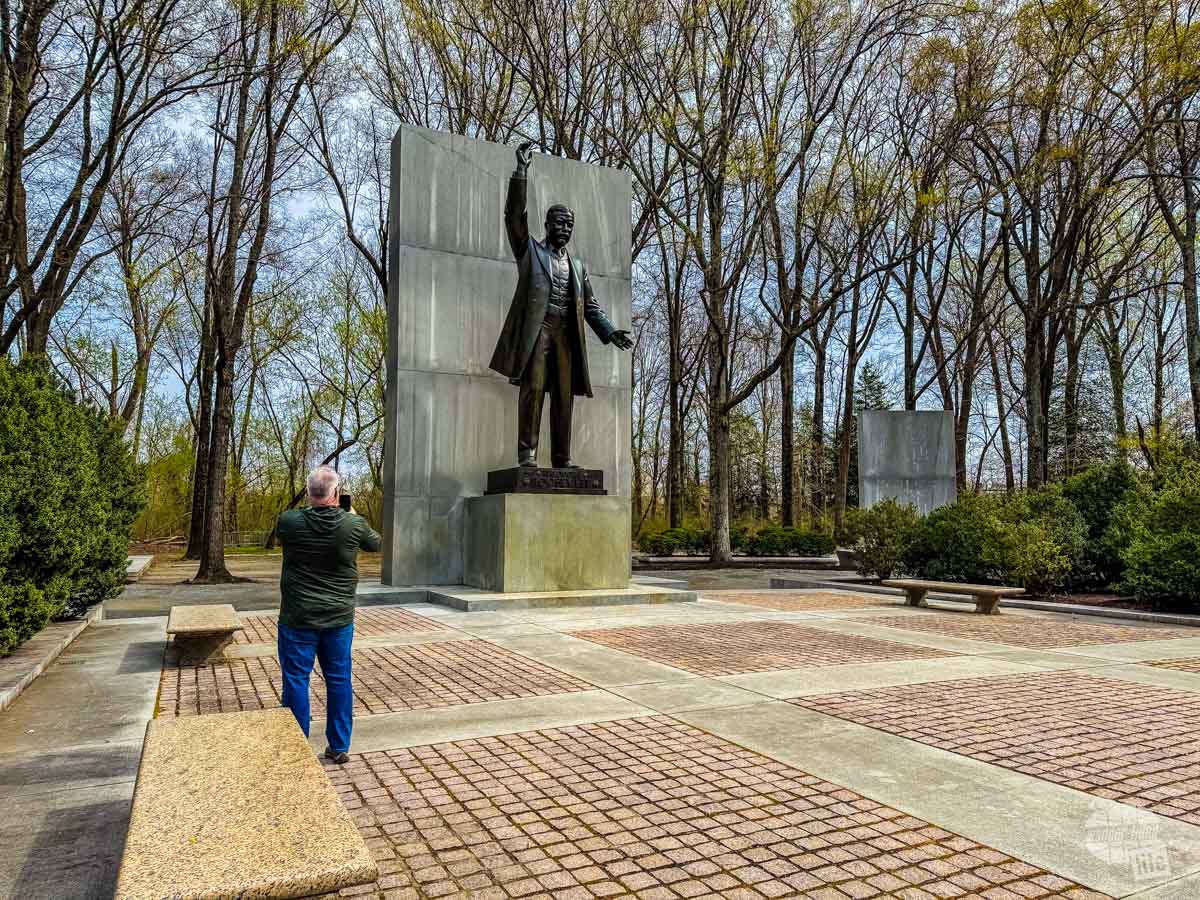
LBJ Memorial Grove on the Potomac – located near the Pentagon, this small park marks the spot where President Johnson often went to escape the stress of the presidency. From the Texas pink granite monolith, you can see the Washington Monument across the Potomac River. It really is a peaceful location despite being within a few miles of the heart of DC.
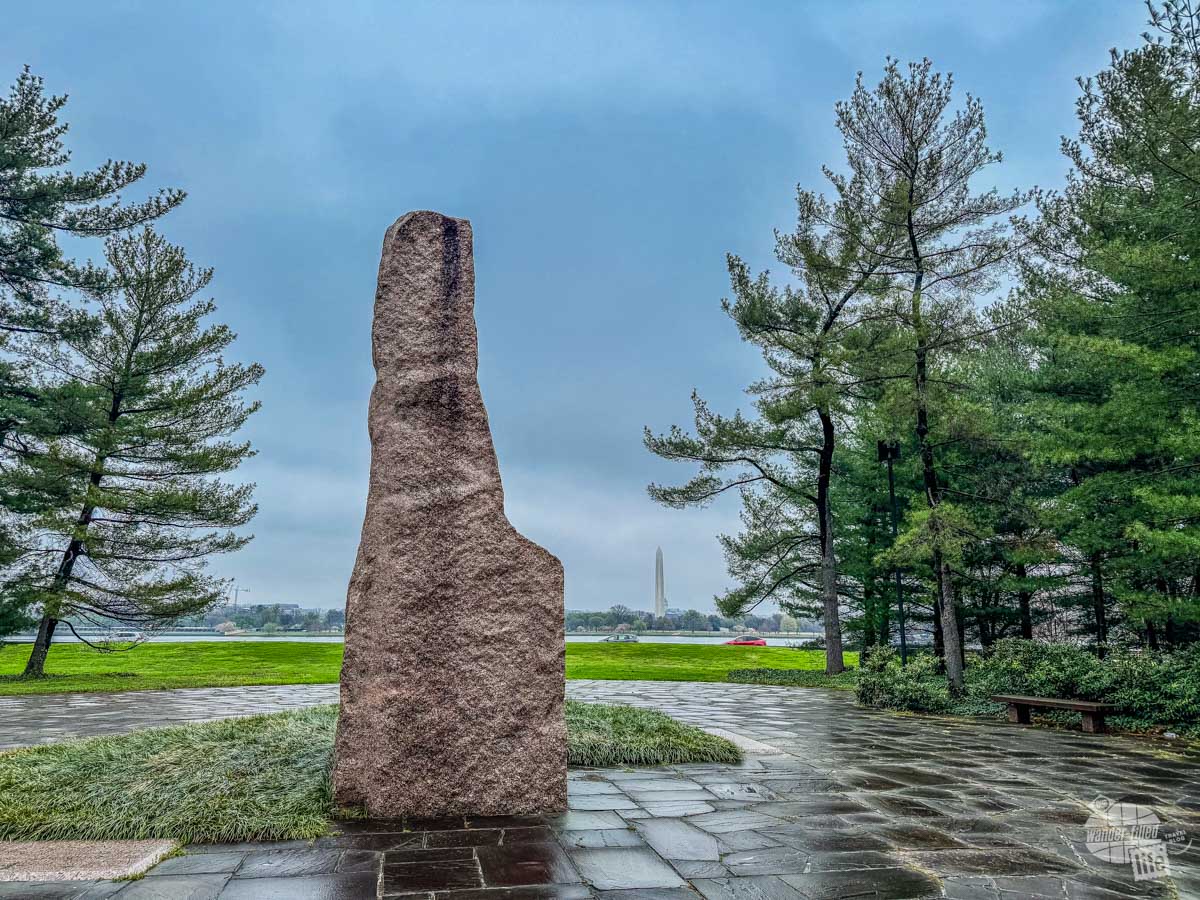
Arlington House, The Robert E. Lee Memorial – despite leading the Confederate Army, Robert E. Lee promoted peace and unity following the American Civil War. This park site preserves the house he shared with his wife and looks at his complicated life and legacy. The house is located high on a hill inside Arlington National Cemetery. Be prepared to pass through security as you enter the grounds. There is a self-guided tour through the house and slave quarters.
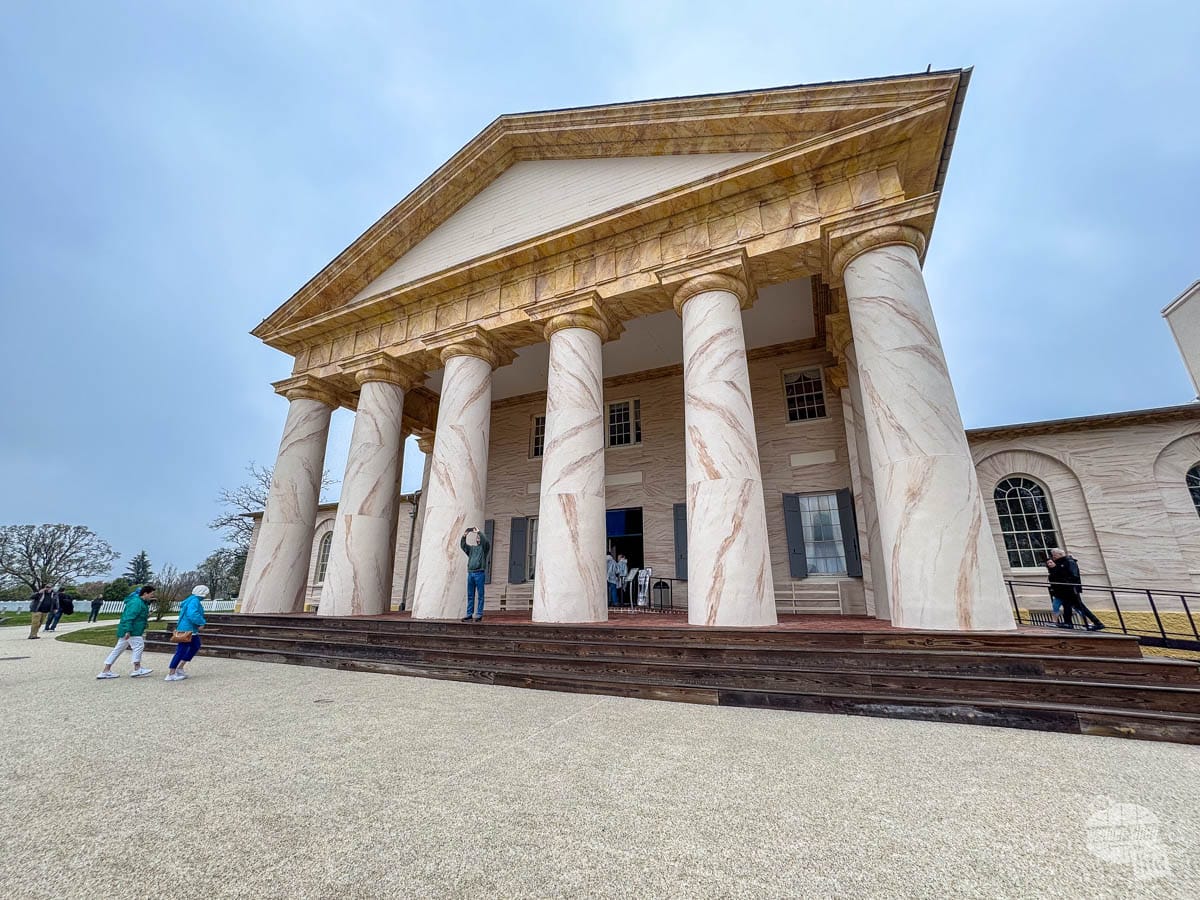
Clara Barton National Historic Site – as the founder of the American Red Cross, Clara Barton dedicated her life to helping others. This site preserves her home in Glen Echo, which was modeled after Red Cross shelters used following the Johnstown Flood. Be sure to time your visit so that you can catch a ranger-guided tour. This site is located right next to Glen Echo Park, making it easy to visit both at the same time.
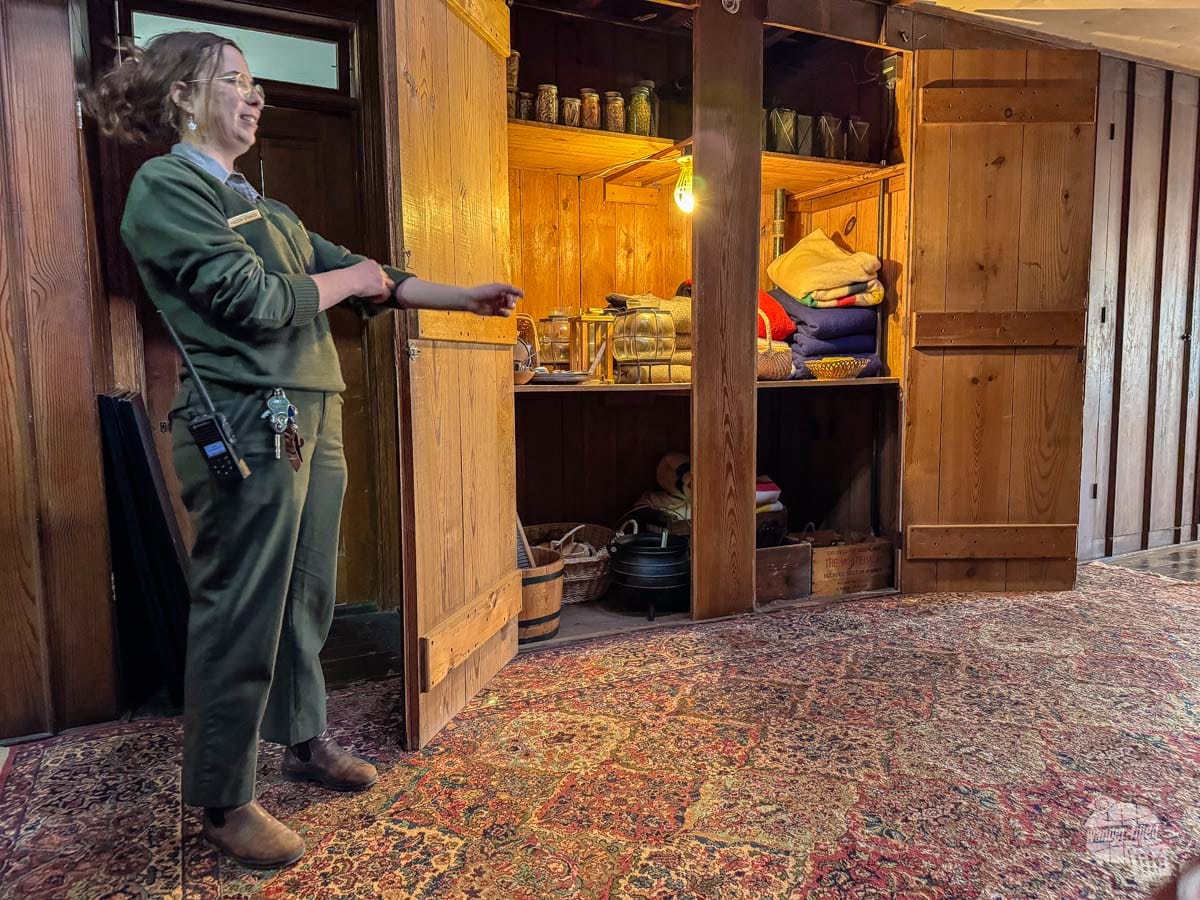
Chesapeake and Ohio Canal National Historical Park – located on the east side of the Potomac River, opposite of Great Falls Park. This park tells the story of the C&O Canal and how it provided passage around the Great Falls. You can view some of the locks and learn how they worked, walk along the towpath and view the falls. This park continues from the DC area for 184.5 miles in total, crossing into both Maryland and West Virginia, following the towpath.
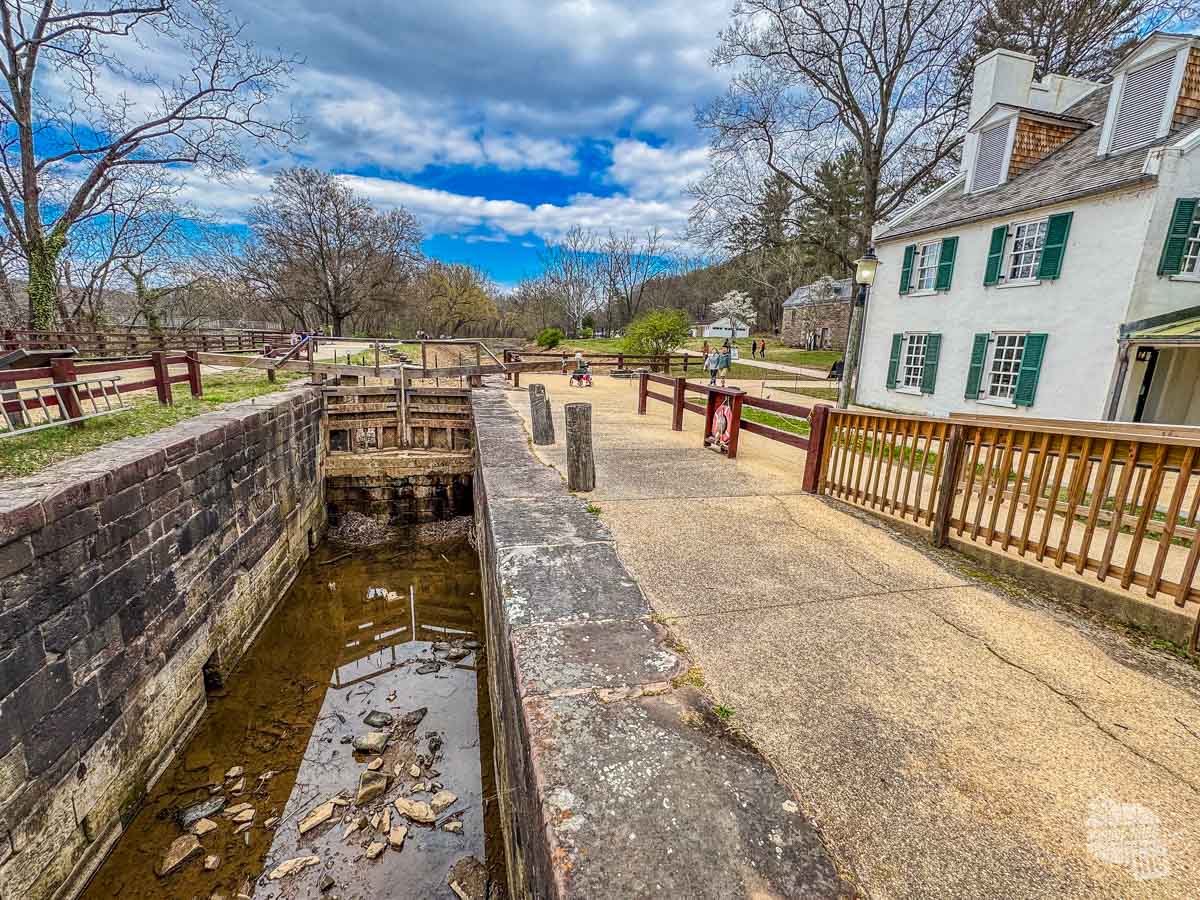
Check out the video below to see more of the sites along the George Washington Memorial Parkway.
More National Parks in the Greater DC Area
Prince William Forest Park – a large park about an hour south of Washington, DC with an interesting history. The park started as the Chopawamsic Recreational Demonstration Area and welcomed low-income, inner-city families to the outdoors. During WWII, it was a training ground for the Office of Strategic Services (OSS), the predecessor to the Central Intelligence Agency (CIA). Today, there is a scenic drive, hiking trails, a picnic area, a campground and several cabins.
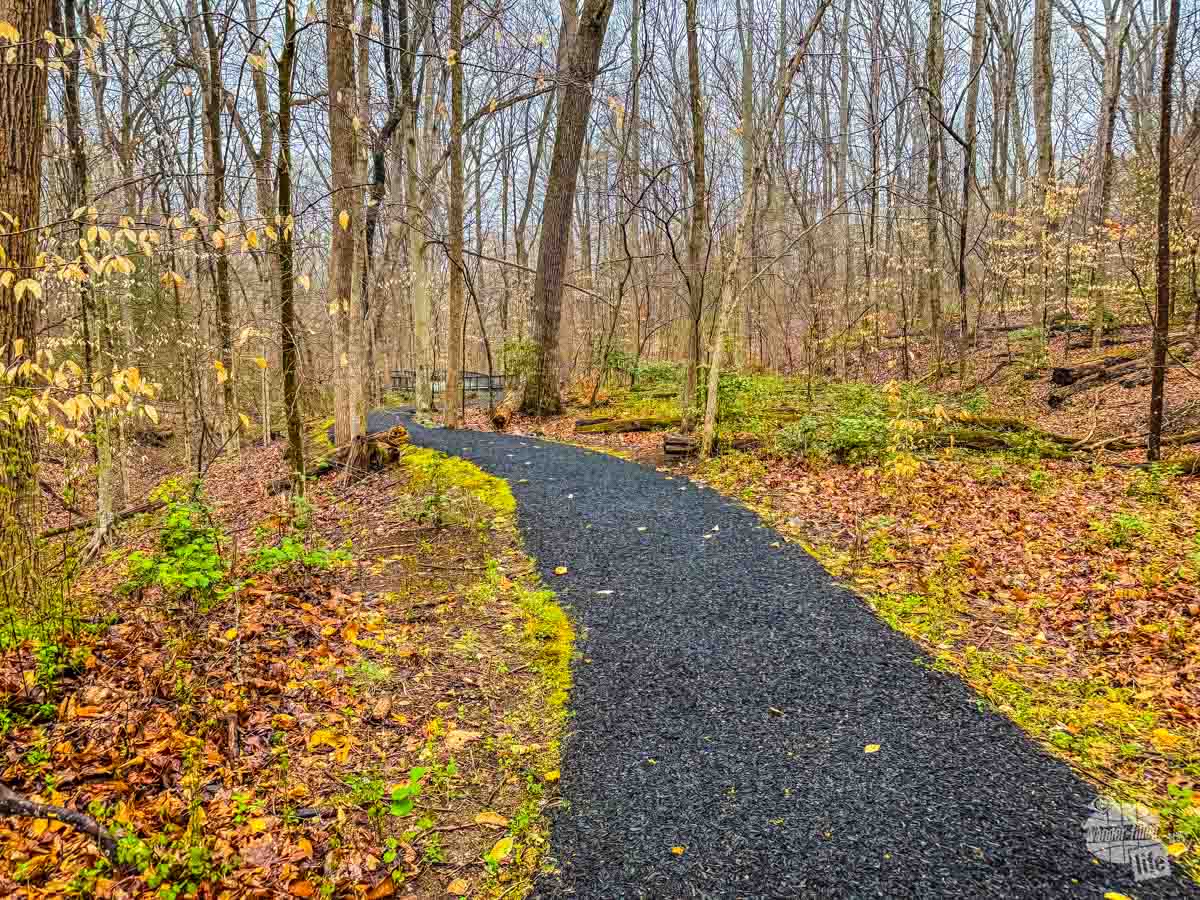
Greenbelt Park – About 10 miles outside Washington, DC on the northeast side, Greenbelt Park is very similar to Rock Creek Park, just smaller. The park consists of several hiking trails and picnic areas, along with a campground. Again, this really just feels like a local city or maybe state park that happens to be managed by the National Park Service.
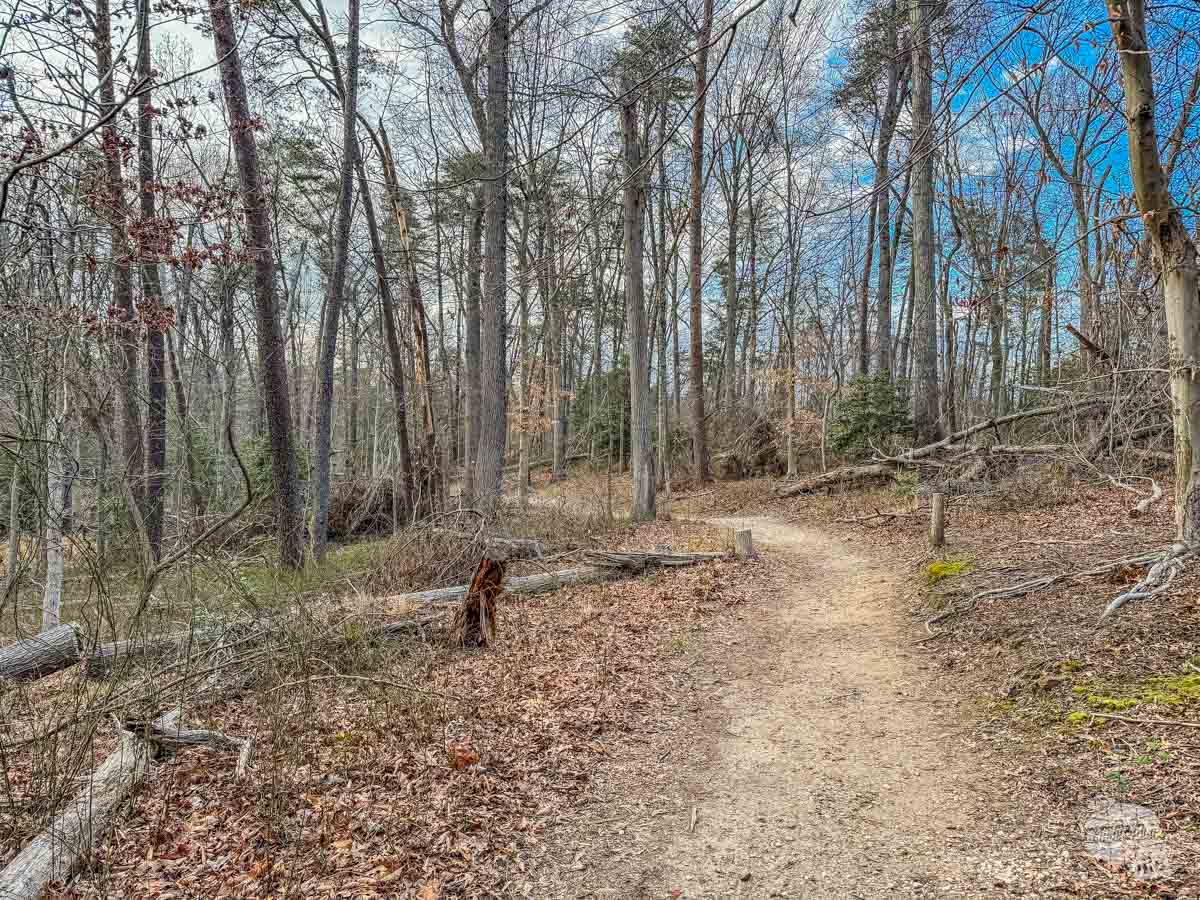
Potomac Heritage National Scenic Trail – this is not a long-distance hiking trail like the Appalachian Trail, but rather a collection of smaller trails and other park units across three states and Washington, DC. Several parks previously mentioned are part of this trail system, including the C&O Canal and Rock Creek Park.
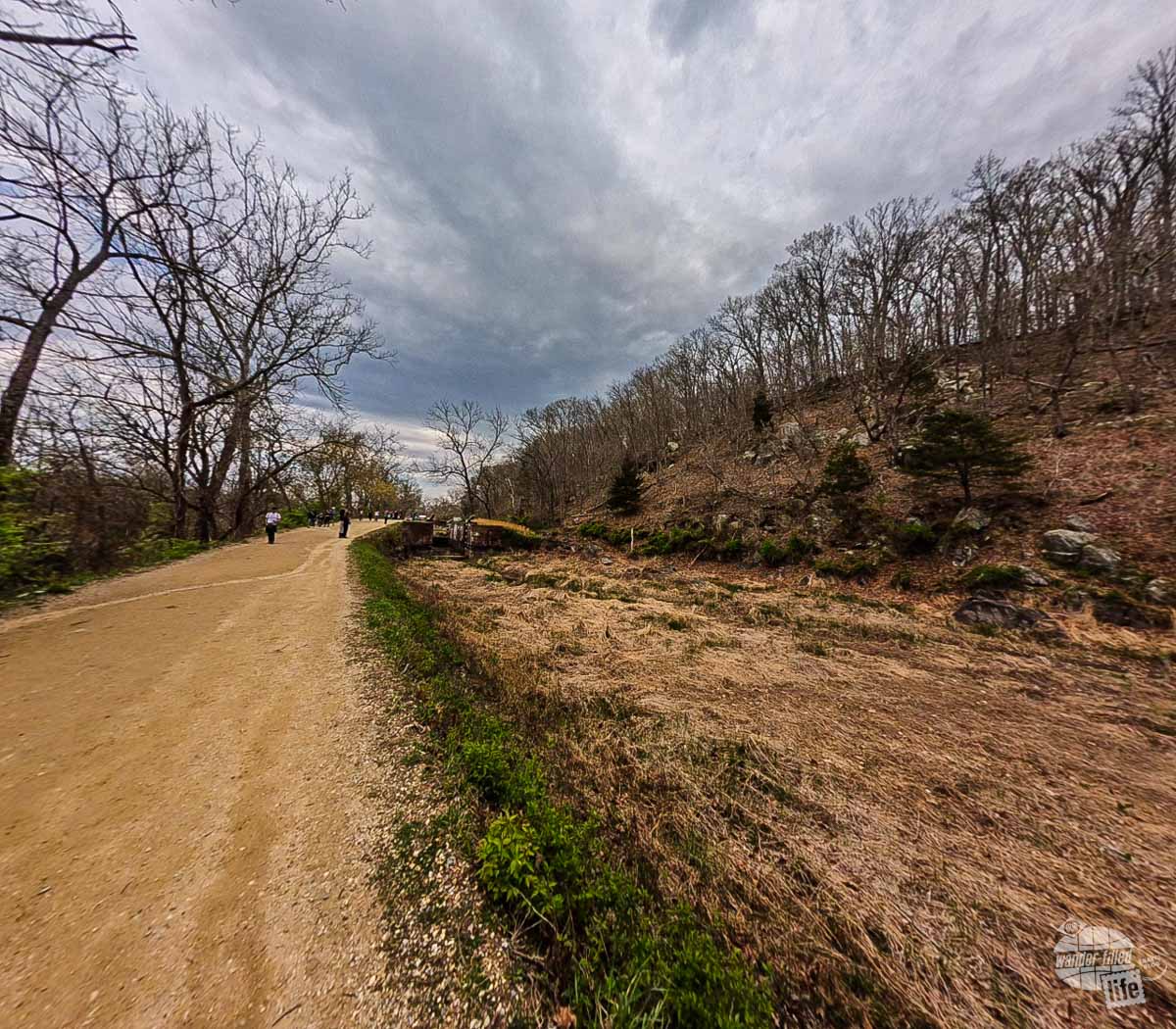
Catoctin Mountain Park – located about 1.5 hours north of downtown Washington, DC, this is park offers hiking trails, fishing, rock climbing, camping and more. We initially planned to visit in April 2024 but simply did not have time to fit it in due to its location.
Washington, DC Area Parks We’ve Written About
We have visited the greater Washington, DC area a few times over the year. We’ve camped with our RV in the summer and stopped while road-tripping in the winter. You can find more information on the parks below with the links provided.
Virginia
- Manassas National Battlefield Park – 45 min west
- Wolf Trap National Park for the Performing Arts – 30 min west
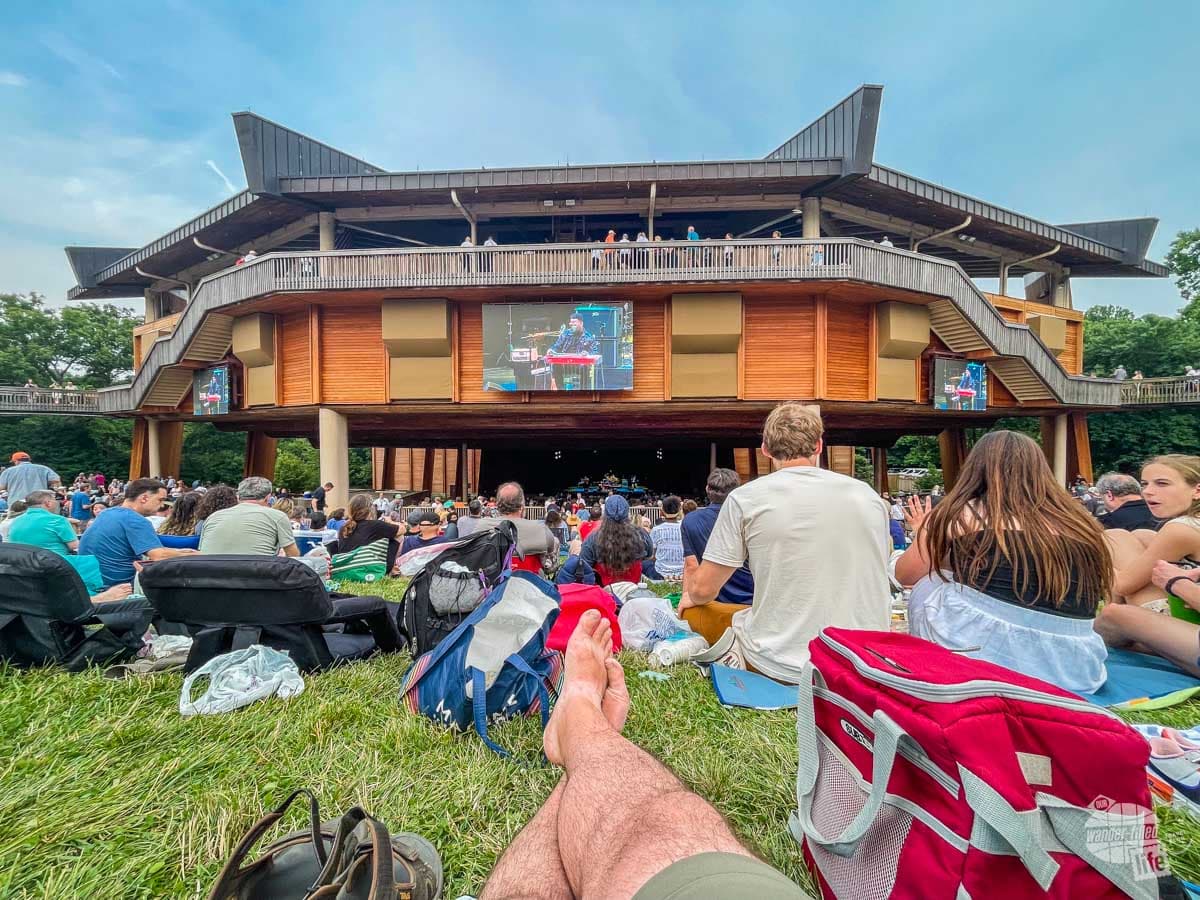
Maryland
- Antietam National Battlefield – 1.5 hrs northwest
- Monocacy National Battlefield – 1 hr north
- Fort Washington Park – 40 min south
- Piscataway Park – 40 min south
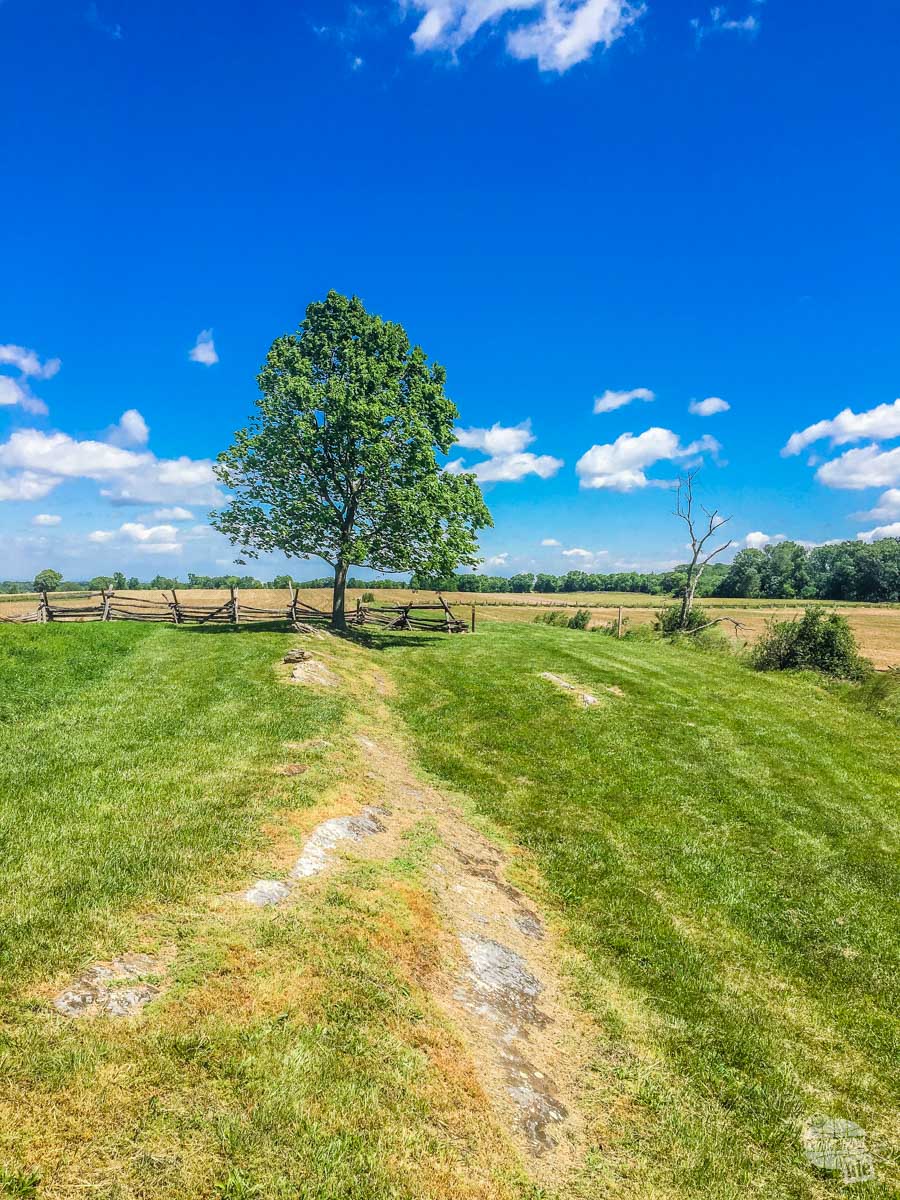
West Virginia
- Harper’s Ferry National Historical Park – 1.5 hrs northwest
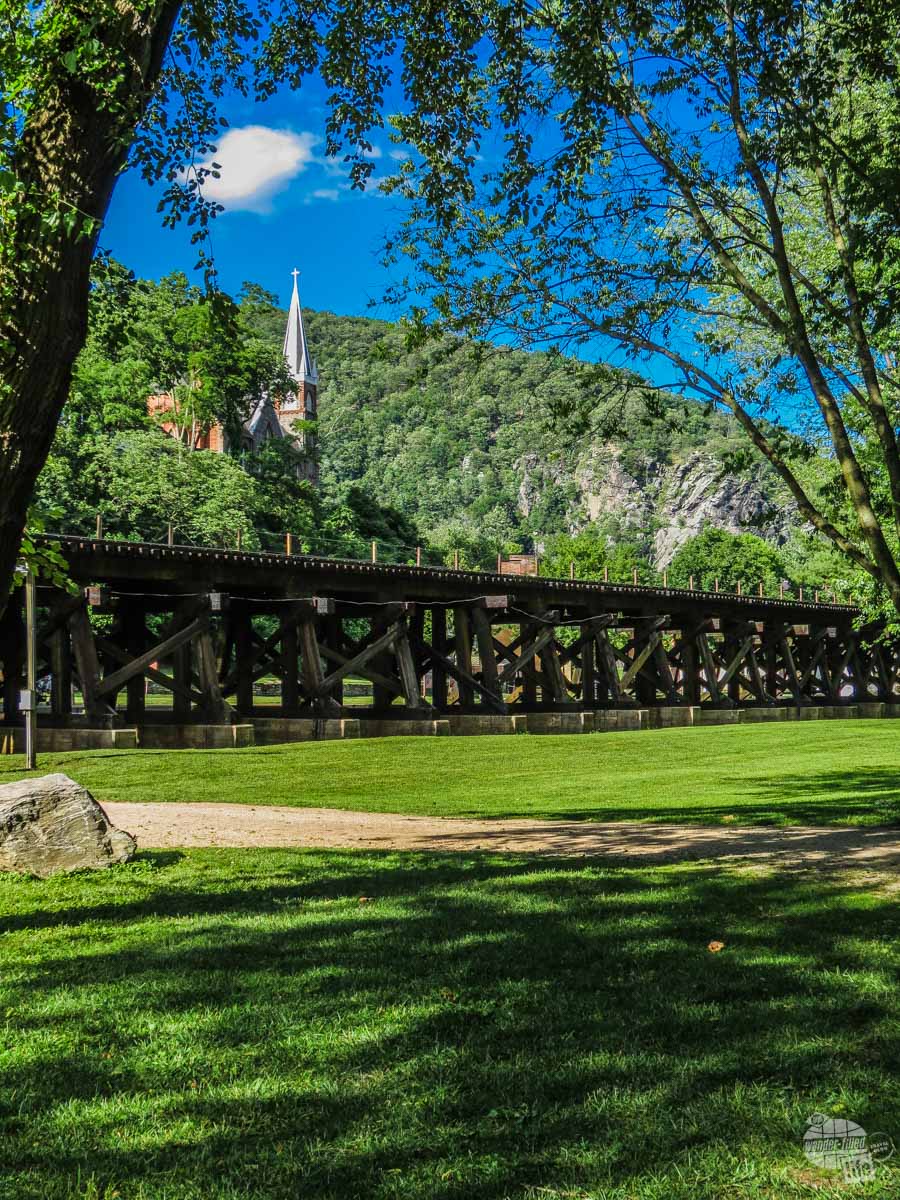
Named National Parks Near Washington, DC
If you are looking to visit an officially designated National Park on your Washington, DC trip, the closest one is Shenandoah National Park.
The northern entrance to Shenandoah is about 1.5 hours west of Washington, DC. The park stretches south from there, with Skyline Drive providing a scenic drive through the park.
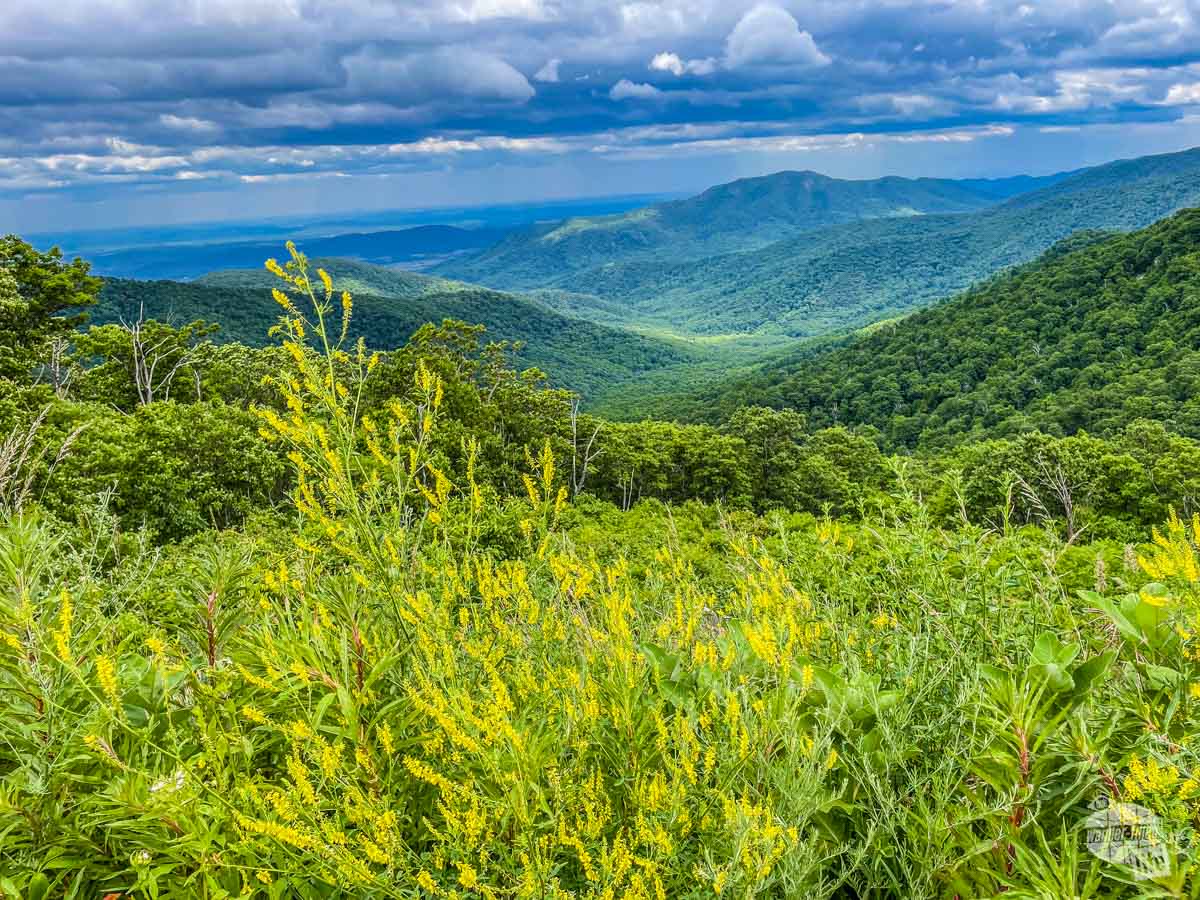
You could visit the park on a day trip, but it’s probably best to do it on your way to or from DC. We’d suggest allowing 1-2 days to visit Shenandoah, though you could certainly spend longer here if you want to do more hiking.
Somewhat in the area is New River Gorge National Park, though it is nearly 5 hours west of Washington, DC. This park is a recreational wonderland, providing opportunities for hiking, whitewater rafting, rock climbing, zip lining and other adventures.
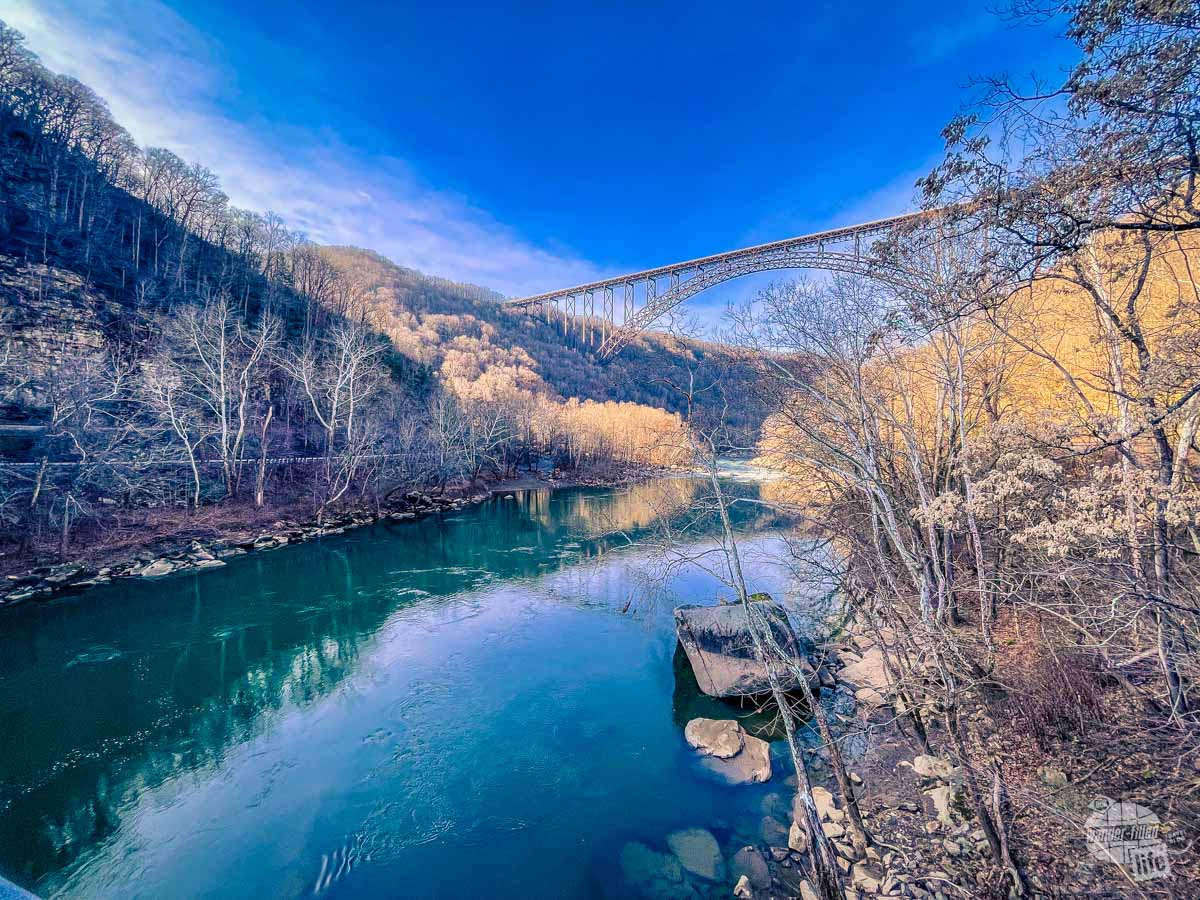
How Long to Visit the DC Area National Parks?
With so many sites in such a small area, having enough time to visit all the national parks in the DC area is a concern. Additionally, many parks have limited hours or are only open seasonally. You’ll need to research that carefully as you start planning your trip, especially since days and times can change based on staffing.
Honestly, to visit all of the parks listed above, you’d probably need at least 2 weeks. We were in town for 6 days in April 2024 and barely fit in the parks covered in depth above. Granted, we did have one very rainy day, on which we only visited two sites. Additionally, we spent about half a day doing a tour of the Capitol.
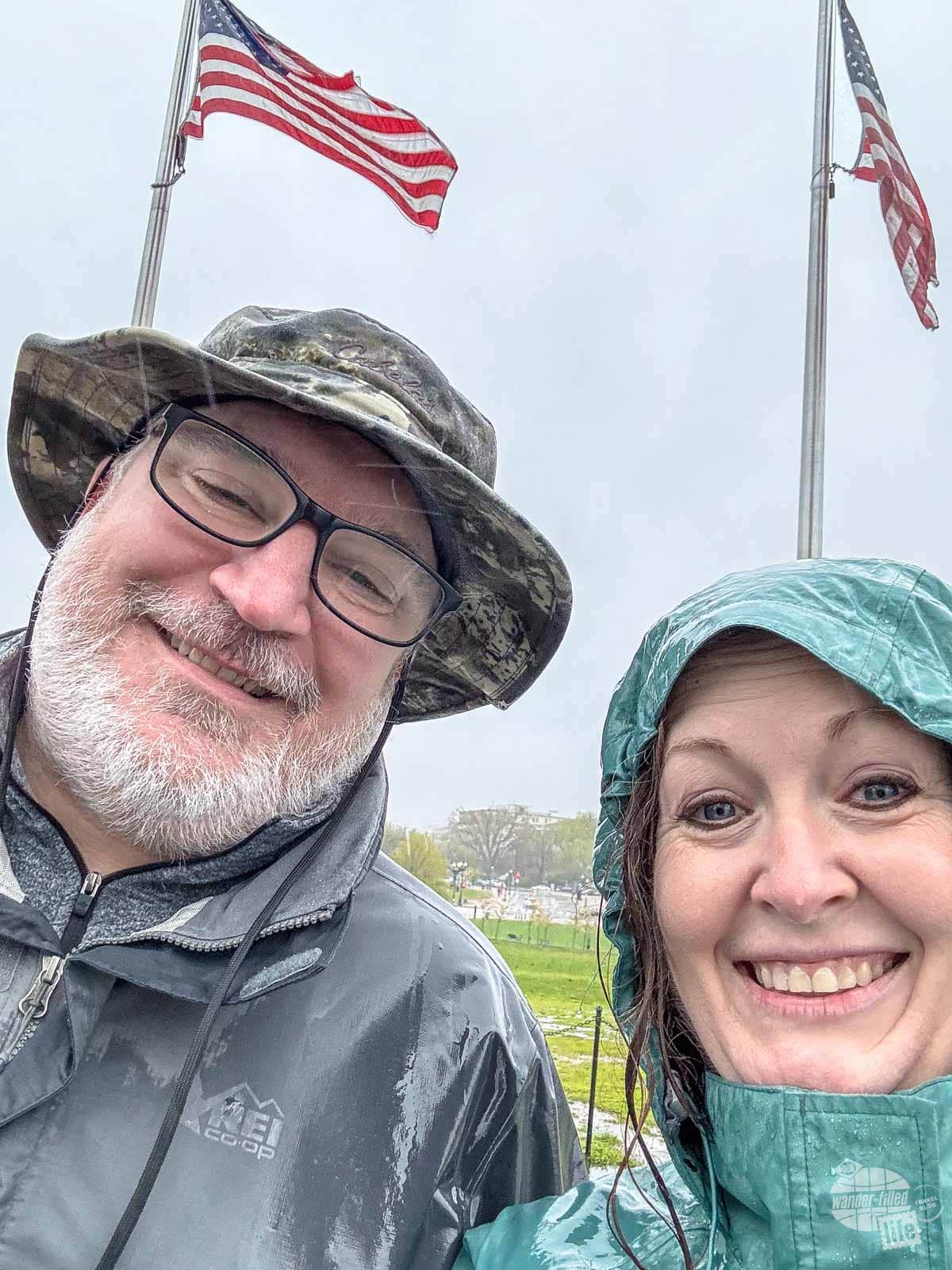
On top of that, we were camping outside the city so getting to and from our campground (Pohick Bay Regional Park) did take some time, especially since we chose to take the metro several days. That was more than an hour’s commute each way.
Had we stayed inside the city, we probably could have done more in less time. With limited hours for many of the sites, I don’t know that we could have saved more than maybe half a day, though.
Of course, this all depends on your interests and how in-depth you want your visit to be. I’m sure some people could spend longer than we did at some sites whereas others would spend less time.
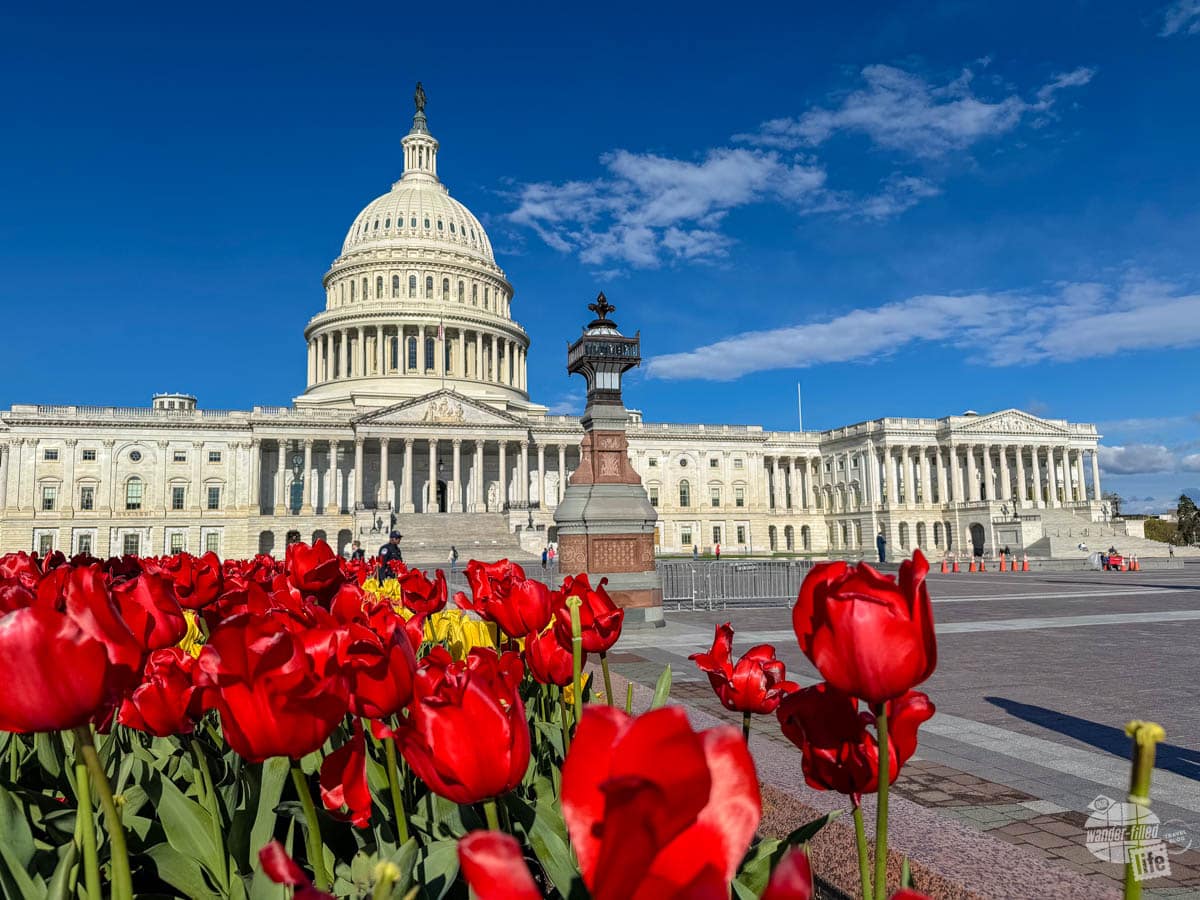
Overall, though, I’d suggest you allow 1-2 weeks to see the Washington, DC area national parks, depending on how far outside the city you want to travel.
Final Thoughts on Visiting All of the Washington, DC National Parks
There is a very interesting mix of national parks in and around Washington, DC.
Of course, there are various monuments and memorials. There are also several historic sites that tell the story of the people and events that shaped the country.
Finally, several parks preserve nature and provide opportunities for locals and visitors to recreate and escape the stress of the city.
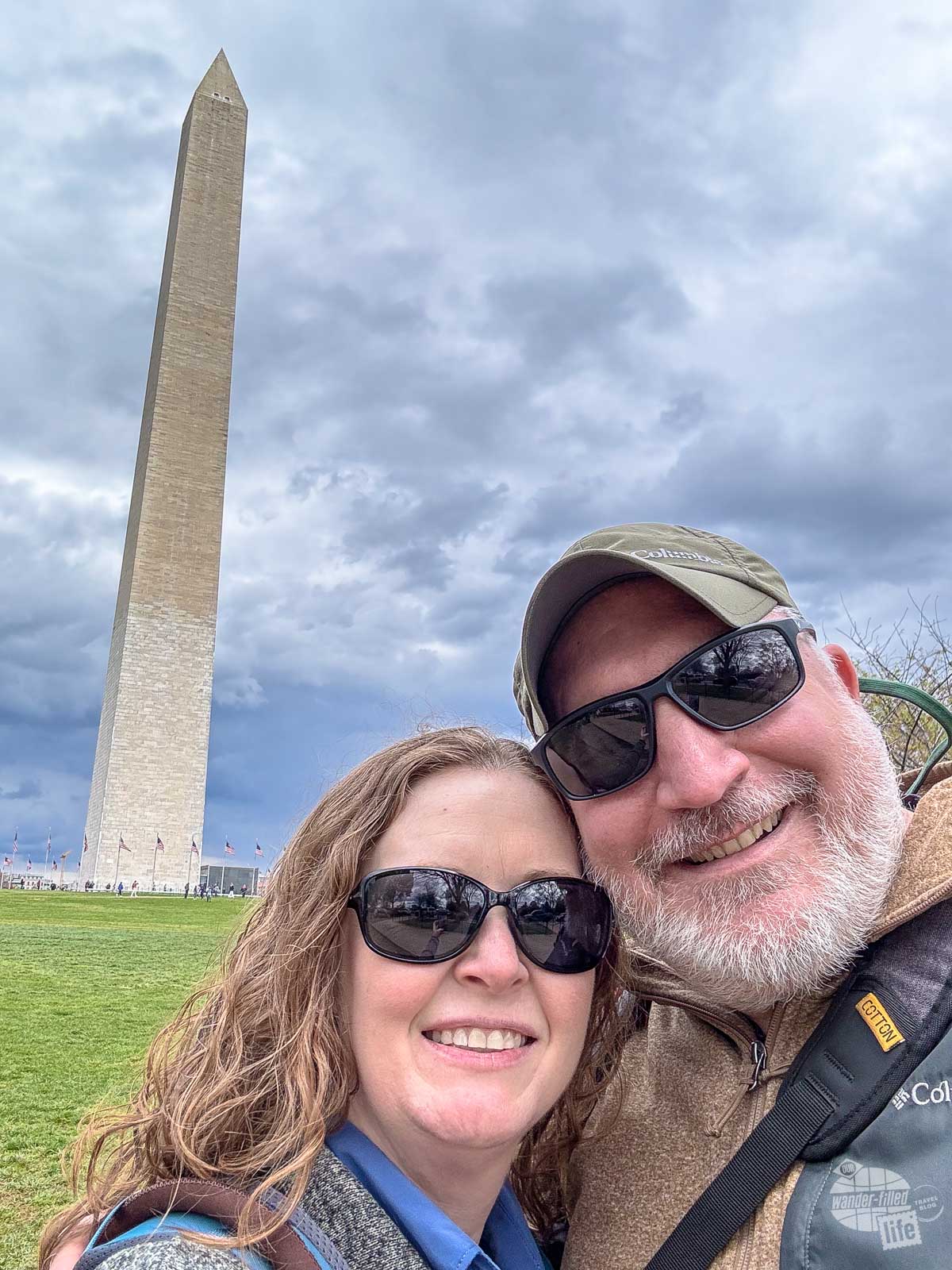
We hope this article serves as a guide for those, like us, who want to visit all of the units of the National Park Service, to navigate the complicated and overlapping designations in Washington, DC.
And while there are a lot of National Parks to visit, that’s not all there is to do in the city. There are tons of great things to see and do in Washington, DC, like seeing the Smithsonian or the National Zoo. We hope that you enjoy your visit to the nation’s capital as much as we did!
Travel Resources
What do you use to find a flight?
We use Skyscanner to find deals on flights. Skyscanner has a great interface and compares tons of airlines for the best pricing and routing. That said, it does not always have every airline and some airlines will have better deals on their website. Still, Skyscanner is a great place to start.
Click here to search for a flight.
What do you use to find a hotel?
We typically stay at Hilton properties, so we use the Hilton website. You can find good Hilton Honors discounts or AAA discounts for a hotel there. We make great use of our free night certificates from our Hilton Honors American Express.
Click here to book a Hilton property.
If there are no Hilton properties available, we use TripAdvisor to read reviews and book the hotel. We find we can get the best price that way.
Click here to search for a hotel.
We recently partnered with Stay22 to add interactive maps to each of our destination posts. This will allow you to see a plethora of hotels and vacation rentals all in one responsive map of the area.
What if I need more space than I can get at a hotel?
We use Vrbo for the times when we have rented a cabin for a weekend getaway, like this cabin in Townsend, TN, or needed to rent a house for a large family vacation. We had a great experience with them in terms of refunding deposits when COVID hit and will continue to use them.
Click here to search for a vacation rental.
Who do you use for rental cars?
As a general rule, we book with Hertz for rental cars. We have had nothing but good experiences with them. Plus, we really like unlimited mileage and not worrying about crossing state lines. We have even rented from Hertz overseas in both Slovenia and Croatia.
Click here to book a rental car.
How about booking a cruise?
We have found some amazing prices for booking a cruise through Cruise Direct. We have saved a lot of money on our cruises compared to what we found elsewhere, making a last-minute Bahamas cruise even cheaper.
Click here to book a cruise.
What if I want to rent an RV?
We highly recommend Outdoorsy for RV rentals. We rented a camper van for a week to visit Rocky Mountain National Park for the elk rut and Custer State Park for the Buffalo Round-Up and had a blast. The program was easy to use and we really enjoyed the freedom of having a camper van for that trip.
Click here to rent an RV.
What do you use for booking tours?
We don’t often book tours. Typically, we like to do stuff on our own. That said, there are some experiences you can’t have any other way. So, when we do want to book a tour, we always check Viator first.
Click here to book a tour.
Do you use anything to get discounts on the road?
We make extensive use of both Good Sam and AAA on the road. Good Sam is normally regarded as a discount card for RVers at campgrounds and Camping World but anyone can use the 5 cents off a gallon at the pump at both Pilot and Flying J.
Click here to get a Good Sam membership.
We have had AAA as long as we have been married and it has more than paid for itself in discounts at hotels, aside from the peace of mind of having roadside assistance. Add in paper maps and the ability to get an international driver’s license and it is more than worth it for any traveler out there.
Click here to get a AAA membership.
